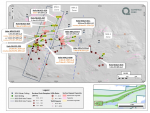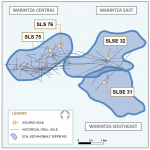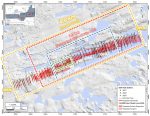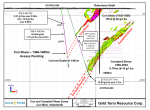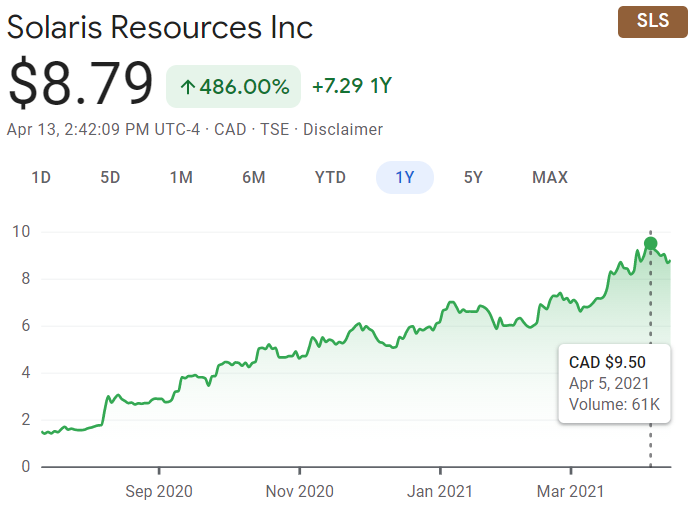I continue to receive questions regarding the direction of the market, to which I can only reply “I don’t know.” I certainly have thoughts about the factors affecting metals markets, but am not under the illusion that I KNOW where the market is headed.
What I do know is that my money is best invested, in tranches, in the best companies in the sector. The best companies are led by the best management teams and, besides the pure exploration companies, are the owners of the highest quality projects.
By high quality, I’m referring to their economics. The best projects have robust economics at today’s metal prices.
It’s my opinion that when market sentiment does eventually change, the bull portion of the next cycle will be HUGE. Along with the supply shortages that I see in the fundamentals of most of the metals, the demand side of the equation looks particularly strong as, globally, the world begins to push toward electrification.
With the short-term direction of the market hard to gauge, one avenue for investors who want to give themselves the potential to profit in the relative immediate future, is to look at exploration companies with a program happening now or in the near future.
Like development companies, the best exploration companies are headed by the best management teams, who have chosen their exploration projects by a set of criteria which gives them the best possible chance at success.
I highly encourage investors to meet, or at the very least call, the people who are running the companies with which they are going to place their money. One of the questions that I think needs to be asked is how the company came to the conclusion that the project they are going to be exploring gives them the best chance at finding a mineral deposit of value.
A company which has been one of my favourites for some time now is Adventus Zinc Corporation (ADZN:TSXV). They are developing their Curipamba project in Ecuador. While I’m looking forward to an updated PEA on Curipamba in the new year, it’s Adventus’ exploration potential with their Pijili and Santiago projects that has my full attention – and excitement – at the moment.
Let’s take a look!
Determining Potential Value in Exploration
Determining the upside potential or value of an exploration company isn’t easy, as much of the criteria is subjective in nature. Here are, in my opinion, a few of the most important points to ponder when it comes to evaluating investment in an exploration company:
#1 – Quality of the Management Team – Take a good look at the management team and any advisors or consultants associated with the company. Past success is a very good indicator of future potential. A good CEO should be able to clearly define the details, mainly the why and how of their upcoming exploration program.
#2 – Jurisdiction –Typically, the regions with the highest potential for uncovering a high value mineral deposit are those which have the most associated risk. It’s imperative to do your due diligence and understand where you are putting your money. Know your risk tolerance – buyer beware.
#3 – A Project’s Historical Work – Answer the following questions:
- In what stage of exploration is the project?
- Has surface work been completed? Grab samples, soil samples, geophysics?
- Is the project drill ready? How were the targets chosen?
- Historical work on the project?
- Has the project already been explored by multiple companies?
- If yes, what were their results? Why should you expect anything different?
NOTE: If a company is looking at exploring or developing a project that has already had a lot of work or exploration completed on it, the company needs to clearly outline how their exploration approach is different from the previous operators, and why it has a chance to be successful.
#4 – Cash – Cash is especially important in the current market. Does the company have enough money to execute on the exploration program that they have planned?
#5 – If unsuccessful, will I be able to sell? – This is an important question to answer and is partially overlapped with the previous point regarding cash. For me, I want to speculate in a company that will have cash remaining after their exploration program is complete in both positive and negative scenarios. An even better situation is to speculate in a company that will have cash remaining and an additional project(s) further down the development path, to which the market can assign value. In my opinion, you don’t want to be invested in a company that doesn’t have any money at this point in the market cycle, let alone own one with a recent unsuccessful exploration program.
Adventus’ Exploration Potential
Let’s use the criteria I just outlined to look at Adventus.
#1 – Quality of the Management Team – In my opinion, the Adventus team is as good as they come in the junior resource sector. The company is led by CEO, Christian Kargl-Simard, who has over 14 years of experience in both technical and finance roles in the mining industry. Additionally, and core to the team, is VP Corporate Development, Sam Leung. Leung has over 10 years of experience in the mining industry, having worked for Lundin Mining Corporation prior to joining Adventus. Finally, and key to Adventus’ exploration efforts in Ecuador, is VP Exploration Jason Dunning. Dunning has over 20 years experience in the mining industry and has worked in a similar role for Alamos Gold Inc., Selwyn Resources Ltd. and Yukon Zinc Corporation.
In addition to the main team, a major strength of the company, in my opinion, is in their association and close connection with Altius Minerals. For those who are unaware, Altius is both a diversified mining royalty company and mineral exploration project generator. Altius is headed by CEO, Brian Dalton, who is also Chairman of Adventus’ Board of Directors.
Also, Dr. Lawrence Winter, Altius’ VP Exploration, is an advisor to Adventus and, in my experience, has a top notch reputation throughout the resource sector.
People are key to the success of any company and, in the case of Adventus, I’m confident that this team will make 2019 a pivotal year in the company’s development.
#2 – Jurisdiction – Adventus’ project exploration and development focus is in Ecuador. For those who are unaware, Ecuador has a rocky past when it comes to mining investment. In my opinion, however, it’s changing in a direction that is attractive to mining investment and is a place where I have invested my cash. Earlier this year, I wrote an article regarding Ecuador’s mining investment attractiveness; for those considering investment in Ecuador, I believe it’s a must-read.
#3 – Historical Work
Adventus is in, what I consider to be, a highly advantageous position when it comes to exploration and development in Ecuador; they are partnered with Salazar Resources, a junior resource company led by a senior Ecuadorian management team.
The Curipamba project was the first deal on which the two companies partnered, giving Adventus the opportunity to earn-in on 75% of the project, given development and payment requirements over a 5-year period.
Since this initial deal, Adventus and Salazar have expanded their relationship into an Ecuador-wide exploration Alliance. The Alliance ownership is 80% Adventus and 20% Salazar, and allows the Alliance Board, which is made up of Sam Leung and Jason Dunning of Adventus, and Fredy Salazar, to pick and choose what they feel are the highest potential projects, and bring them into the Alliance for exploration and development.
Pijili Project
The first project to be brought into the Alliance is the Pijili project, which was granted to Salazar by the Republic of Ecuador.
The Pijili project consists of 3 concessions totalling 3,246 hectares, and is located in the Ecuadorian province of Azuay. Its potential has been revealed only through the legally permitted artisanal mining which is currently taking place – exploration through modern techniques has yet to take place.
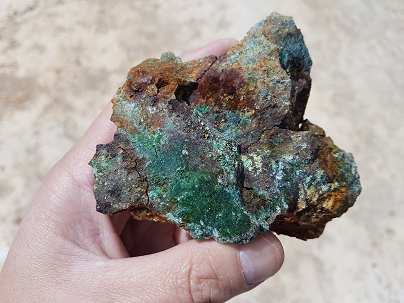
Artisanal miners are mining precious metals bearing structures via several small open pits and underground tunnels. Also, Salazar notes that there is visible evidence of copper mineralization along the walls of the small open pits.
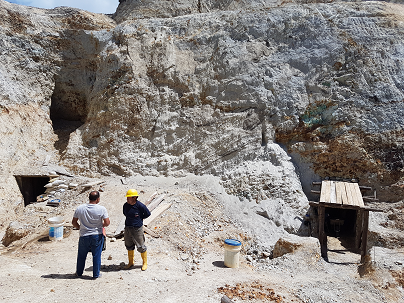
In their most recent news release, Adventus announced the commencement of an airborne MobileMT geological survey of the Pijili and Santiago projects. As VP of Exploration, Jason Dunning, cites in the news release,
“MobileMT will greatly enhance drill hole targeting by defining high-priority targets for follow-up in early 2019. This is the first time there will be a deep penetrating, uniform dataset for Pijilí and Santiago projects that will allow us to more accurately visualize the geological and structural framework in 3D to define potentially prospective host rocks for intrusion-related mineralization.”
Pijili presents a blank slate for exploration, one that I believe holds a ton of mineral potential.
Santiago Project
The second project brought into the Alliance is the Santiago project, which is roughly 110 km west of Lundin’s Forte del Norte gold deposit. Santiago consists of a single concession, which covers an area of 2,350 hectares.
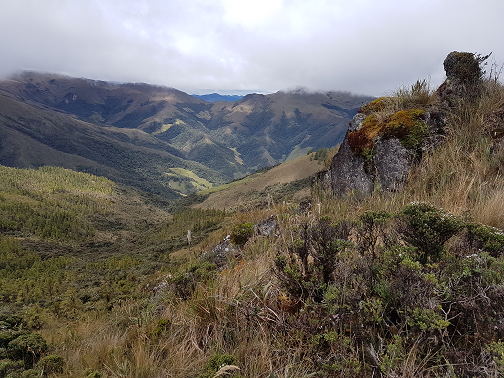
Unlike Pijili, Santiago has seen the use of modern exploration techniques, which has exposed a series of vein occurrences. The occurrences have yielded good reconnaissance chip sampling results. Here are a few highlights, which can be found on Salazar’s website and SEDAR.
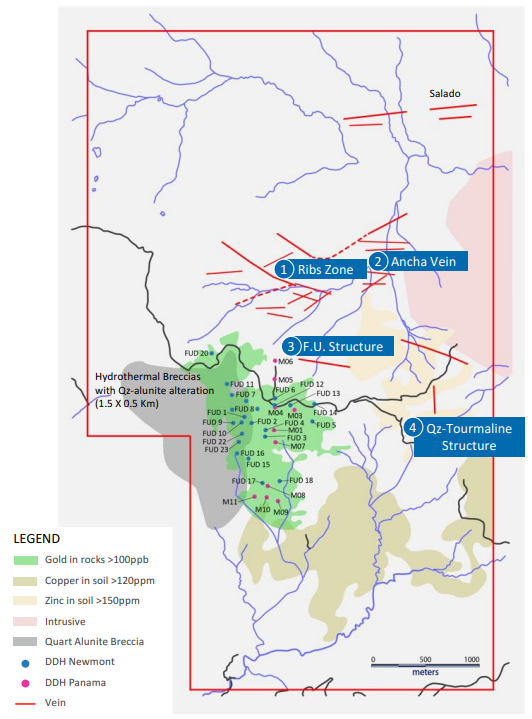
Espanola Vein
2.0 m @ 28.1g/t Au and 231 g/t Ag
1.0 m @ 26.0 g/t Au and 242 g/t Ag
Quartz-Tourmaline Vein
1.9 m @1.19 g/t Au, 14.3 g/t Ag and 296 ppm Mo
3.3 m @ 0.59g/t Au, 36.6 g/t Ag and 390 ppm Mo
Ribs Zone and Ancha Vein
1 m @ 1.29 g/t Au and > 100 g/t Ag
1 m @1.65 g/t Au and > 100 g/t Ag
F.U. Structure
1.40 m @ 4.8 g/t Au and 378 g/t Ag
1.20 m @ 6.4 g/t Au and 136 g/t Ag
In addition to the chip samples, Santiago has seen historical drilling on the project by a previous operator, Newmont Mining Corporation.
The historical results are very intriguing as they exhibit characteristics of a Cu-Au porphyry system. I must, however, caution anyone from drawing any conclusions from these results as they are not confirmable – the drill core is unavailable.
Here are a few of the highlights, which can be found on SEDAR:
Hole FU 01 – Interval 0 to 323 m, 0.37 g/t Au, 0.23% Cu – 0.47% CuEq
Hole FU 02 – Interval 129 to 300 m, 0.5 g/t Au, 0.33% Cu – 0.66% CuEq
Hole FU 08 – Interval 0 to 300 m, 0.24 g/t Au, 0.11% Cu – 0.27% CuEq
As mentioned earlier, Adventus has announced an airborne MobileMT geological survey of Santiago, which will assist the exploration team in identifying the highest potential drill targets.
Personally, I will be watching for news from the airborne work and the targets that Adventus decides to pursue. In my opinion, there’s a lot of potential here.
#4 – Cash – In Adventus’ current corporate presentation, the company lists their cash position as $10 million, as of October 30th 2018. Given the current market dynamics, this is a great position to be in. Additionally, I might add, Adventus has enjoyed the uncanny ability to raise money through this bear market portion of the resource cycle, which I expect will continue in the future.
#5 – Downside Risk – Currently, as an investor of Adventus, I believe the biggest risk to my capital comes from the jurisdiction – Ecuador, for reasons I outlined in my article. While there’s risk of failure in exploration at Pijili and Santiago, I don’t see the stock price taking a big hit for failure. Given the MCAP and the value I assign to Adventus’ assets, I see little to no value assigned to exploration upside at Pijili or Santiago.
Furthermore, given Adventus’ cash position, their access to funds and the assets they hold under management, I believe the risk to reward potential presented by the exploration is fantastic.
Conclusion
The end of the year is upon us and with it typically comes a great opportunity to buy the best junior resource companies at a discount. While no one can predict the direction of a market with any consistency, buying the highest quality companies, with catalysts for share price appreciation, puts us, in my opinion, in the best possible position to profit.
To me, Adventus is one of those high quality companies that give the investor multiple avenues for success. First, you have their flagship Curipamba project, which should have an updated PEA early in the new year. Second, you have their high potential exploration projects, Pijili and Santiago, whose upside potential, in my opinion, hasn’t been factored into Adventus’ MCAP as of yet. Third, you have Adventus’ portfolio of Irish projects, for which they are actively looking to find a JV partner. Finally, you have Adventus’ large stake in Canstar Resources, who will be beginning their inaugural exploration program on their Newfoundland based projects next year.
I’m looking forward to 2019!
Don’t want to miss a new investment idea, interview or financial product review? Become a Junior Stock Review VIP now – it’s FREE!
Until next time,
Brian Leni P.Eng
Founder – Junior Stock Review
Disclaimer: The following is not an investment recommendation, it is an investment idea. I am not a certified investment professional, nor do I know you and your individual investment needs. Please perform your own due diligence to decide whether this is a company and sector that is best suited for your personal investment criteria. I do own shares in Adventus Zinc Corporation. All Adventus Zinc Corporation analytics were taken from their website and press release. I have NO business relationship with Adventus Zinc Corporation.
November 30, 2018
GOLD:
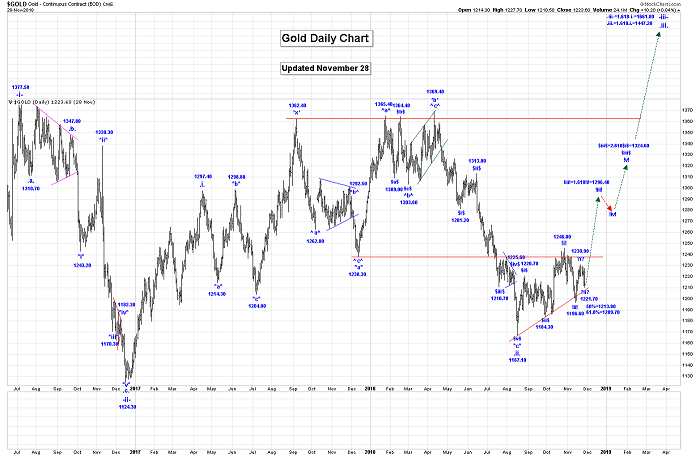
Short Term Update:
What a day! This is incredible! We called it with our wave counts, and now it’s really happening as the Fed may have just blinked!
Within wave .iii. we are now working on our first impulsive sequence, as shown on our “Daily Gold Chart”.
Within that first impulsive sequence we believe that we are working on a subdividing wave $iii$. Within wave $iii$, wave !i! ended at the 1246.00 high and all of wave !ii! at 1196.60.
We are now rallying in wave !iii!, which has an initial target of:
!iii!=1.618!i!=1296.40!
Within wave !iii! it looks like we are subdividing again as shown on the Daily Gold Chart. It looks like wave ?i? ended at 1230.90 and that we are now falling in wave ?ii?.
Our retracement levels for the end of wave ?ii? were:
50% = 1213.80;
61.8% = 1209.70.
Our report card on that call: Bingo!
We expected that gold should drop a little further before all of wave ?ii? ends, and that’s exactly what happened.
Longer term our first projection for the end of wave .iii. is:
.iii. = 1.618.i. = 1447.20.
We do have higher projections. Of course, wave .iii. should subdivide into a 5 wave impulsive sequence in its journey higher.
Trading Recommendation: Long gold. Use puts as stops.
Active Positions: We are long, with puts as stops!
Silver:
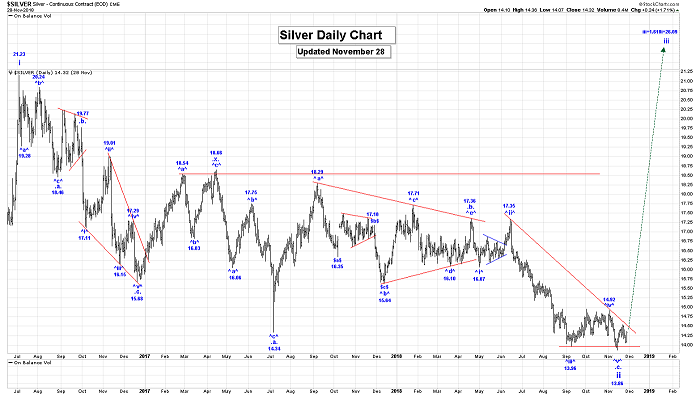
Short Term Update:
In the very short term, silver has been correcting the rally from 13.86 to 14.54. Silver could be ready to move higher again quite soon.
We are working on the assumption that all of wave ii ended at the 13.86 low and that we are now starting to work higher…
In the initial stages of wave .iii.
We have been waiting to see a very big up day to confirm this assumption.
Silver will accelerate higher (and perhaps quite dramatically) with gold once the 95.93 low in the USDX gives way.
We also need to break above our red downtrend line that is shown on the Daily Silver Chart that connects 17.35 and 14.92.
Our first projection for the end of wave iii is:
iii = 1.618i = 26.09.
Trading Recommendation: Long silver. Use a put as a stop.
Active Positions: We are long, with puts as stops!
GDX & Gold Stocks:
GDX 60 Min Chart:
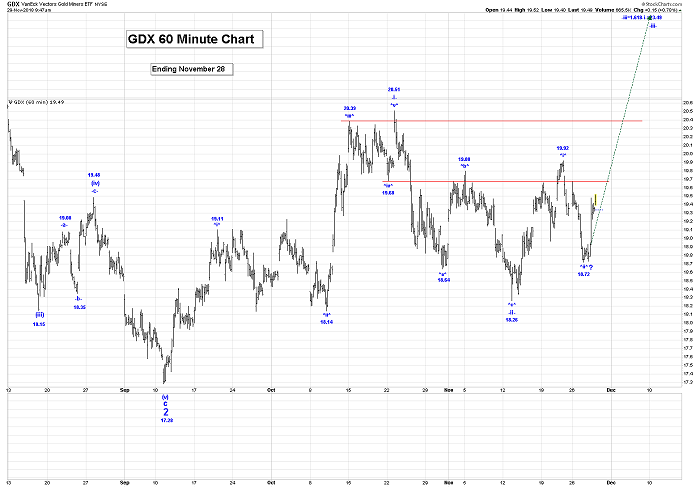
GDX Daily Chart:
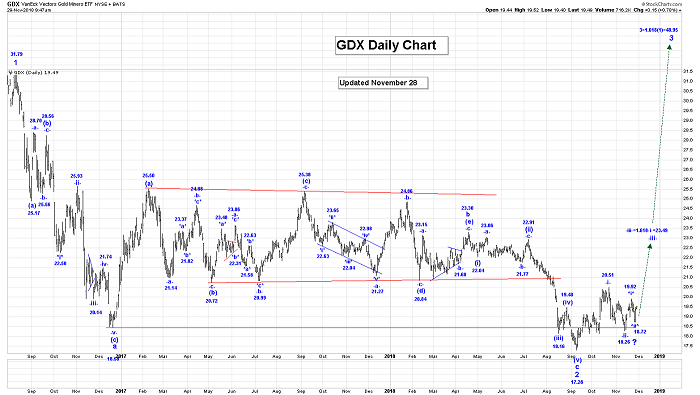
Short Term Update:
We have now updated our count to suggest that all of wave ^i^ ended at the 19.92 high and that all or most of wave ^ii^ at the 18.72 low.
If that is the case then we should now be moving higher in wave ^iii^, as the next big event in this market.
We are now working on the assumption that all of wave -ii- is complete at the 18.26 low and that we are now rallying in wave -iii-.
Our first projection for the end of wave -iii- is:
-iii- = 1.618-i- = 23.49.
Longer term our first projection for the end of wave 3 is:
3 = 1.618(1) = 48.95.
We have updated all of the following counts, for the following:
Kinross: Has now completed its minimum requirements for a completed wave (ii), at the 2.38 low. Wave (iii) rally is now underway.
Barrick: We have completed the minimum requirements for a completed wave (ii) at the 9.53 low. Wave (iii) rally is now underway.
HUI: We have completed the minimum requirements for a completed wave (ii), at the 131.12 low. Wave (iii) rally is now underway.
XAU: We have completed the minimum requirements for a completed wave 2 at the 60.59 low. Wave 3 rally is now underway.
Trading Recommendation: We continue to suggest buying all of the above gold stocks and indices, for a long term hold.
Active Positions: We are long the GDX, ABX, KGC, NEM, SSR, and TSX:XGD with no stops!!
Free Offer For Website Readers: Please send me an Email to admin@captainewave.com and I’ll send you our free “Gold could Hit $1300 By Christmas!” report. We highlight our new weekly wave counts chart for GDX, which suggests that $1300 gold by Christmas can really happen! We discuss tactical approaches to make money on the play!
Thank-you!
Captain Ewave & Crew
Email: admin@captainewave.com
Website: www.captainewave.com
Risk: CAPTAINEWAVE.COM IS AN IMPERSONAL ADVISORY SERVICE. AND THEREFORE, NO CONSIDERATION CAN OR IS MADE TOWARD YOUR FINANCIAL CIRCUMSTANCES. ALL MATERIAL PRESENTED WITHIN CAPTAINEWAVE.COM IS NOT TO BE REGARDED AS INVESTMENT ADVICE, BUT FOR GENERAL INFORMATIONAL PURPOSES ONLY. TRADING STOCKS DOES INVOLVE RISK, SO CAUTION MUST ALWAYS BE UTILIZED. WE CANNOT GUARANTEE PROFITS OR FREEDOM FROM LOSS. YOU ASSUME THE ENTIRE COST AND RISK OF ANY TRADING YOU CHOOSE TO UNDERTAKE. YOU ALSO AGREE TO BEAR COMPLETE RESPONSIBILITY FOR YOUR INVESTMENT RESEARCH AND DECISIONS AND ACKNOWLEDGE THAT CAPTAINEWAVE.COM HAS NOT AND WILL NOT MAKE ANY SPECIFIC RECOMMENDATIONS OR GIVE ADVICE TO YOU OR ANY OF ITS CLIENTS UPON WHICH THEY SHOULD RELY. CAPTAINEWAVE.COM SUGGESTS THAT THE CLIENT/MEMBER TEST ALL INFORMATION AND TRADING METHODOLOGIES PROVIDED AT OUR SITE THROUGH PAPER TRADING OR SOME OTHER FORM OF TESTING. CAPTAINEWAVE.COM, ITS OWNERS, OR ITS REPRESENTATIVES ARE NOT REGISTERED AS SECURITIES BROKER-DEALERS OR INVESTMENT ADVISORS EITHER WITH THE U.S. SECURITIES AND EXCHANGE COMMISSION OR WITH ANY STATE SECURITIES REGULATORY AUTHORITY. WE RECOMMEND CONSULTING WITH A REGISTERED INVESTMENT ADVISOR, BROKER-DEALER, AND/OR FINANCIAL ADVISOR. IF YOU CHOOSE TO INVEST WITH OR WITHOUT SEEKING ADVICE FROM SUCH AN ADVISOR OR ENTITY, THEN ANY CONSEQUENCES RESULTING FROM YOUR INVESTMENTS ARE YOUR SOLE RESPONSIBILITY.
ALL INFORMATION POSTED IS BELIEVED TO COME FROM RELIABLE SOURCES. CAPTAINEWAVE.COM DOES NOT WARRANT THE ACCURACY, CORRECTNESS, OR COMPLETENESS OF INFORMATION AVAILABLE FROM ITS SERVICE AND THEREFORE WILL NOT BE LIABLE FOR ANY LOSS INCURRED. DUE TO THE ELECTRONIC NATURE OF THE INTERNET, THE CAPTAINEWAVE.COM WEBSITE, ITS E-MAIL & DISTRIBUTION SERVICES AND ANY OTHER SUCH “ALERTS” COULD FAIL AT ANY GIVEN TIME. CAPTAINEWAVE.COM WILL NOT BE RESPONSIBLE FOR UNAVAILABILITY OF USE OF ITS WEBSITE, NOR UNDELIVERED E-MAILS, OR “ALERTS” DUE TO INTERNET BANDWIDTH PROBLEMS, EQUIPMENT FAILURE, OR ACTS OF GOD. CAPTAINEWAVE.COM DOES NOT WARRANT THAT THE TRANSMISSION OF E-MAILS, OR ANY “ALERT” WILL BE UNINTERRUPTED OR ERROR-FREE. CAPTAINEWAVE.COM WILL NOT BE LIABLE FOR THE ACTS OR OMISSIONS OF ANY THIRD PARTY WITH REGARDS TO CAPTAINEWAVE.COM DELAY OR NON-DELIVERY OF THE CAPTAINEWAVE.COM NIGHTLY EMAILS OR “ALERTS”. FURTHER, WE DO NOT RECEIVE ANY FORM OF PAYMENT OR OTHER COMPENSATION FOR PUBLISHING INFORMATION, NEWS, RESEARCH OR ANY OTHER MATERIAL CONCERNING ANY SECURITIES ON OUR SITE OR PUBLISH ANY INFORMATION ON OUR SITE THAT IS INTENDED TO AFFECT OR INFLUENCE THE VALUE OF SECURITIES.
THERE IS NO GUARANTEE PAST PERFORMANCE WILL BE INDICATIVE OF FUTURE RESULTS. NO ASSURANCE CAN BE GIVEN THAT THE RECOMMENDATIONS OF CAPTAINEWAVE.COM WILL BE PROFITABLE OR WILL NOT BE SUBJECT TO LOSSES. ALL CLIENTS SHOULD UNDERSTAND THAT THE RESULTS OF A PARTICULAR PERIOD WILL NOT NECESSARILY BE INDICATIVE OF RESULTS IN FUTURE PERIODS. THE RESULTS LISTED AT THIS WEBSITE ARE BASED ON HYPOTHETICAL TRADES. PLAINLY SPEAKING, THESE TRADES WERE NOT ACTUALLY EXECUTED. HYPOTHETICAL OR SIMULATED PERFORMANCE RESULTS HAVE CERTAIN INHERENT LIMITATIONS. UNLIKE AN ACTUAL PERFORMANCE RECORD, SIMULATED TRADES DO NOT REPRESENT ACTUAL TRADING. ALSO, SINCE THE TRADES HAVE NOT ACTUALLY BEEN EXECUTED, THE RESULTS MAY HAVE OVER OR UNDER COMPENSATED FOR THE IMPACT, IF ANY, OF CERTAIN MARKET FACTORS SUCH AS LACK OF LIQUIDITY. YOU MAY HAVE DONE BETTER OR WORSE THAN THE RESULTS PORTRAYED. NO REPRESENTATION IS BEING MADE THAT ANY ACCOUNT WILL OR IS LIKELY TO ACHIEVE PROFITS OR LOSSES SIMILAR TO THOSE SHOWN. NO INDEPENDENT PARTY HAS AUDITED THE HYPOTHETICAL PERFORMANCE CONTAINED AT THIS WEBSITE, NOR HAS ANY INDEPENDENT PARTY UNDERTAKEN TO CONFIRM THAT THEY REFLECT THE TRADING METHOD UNDER THE ASSUMPTIONS OR CONDITIONS SPECIFIED HEREAFTER. WHILE THE RESULTS PRESENTED AT THIS WEBSITE ARE BASED UPON CERTAIN ASSUMPTIONS BELIEVED TO REFLECT ACTUAL TRADING CONDITIONS, THESE ASSUMPTIONS MAY NOT INCLUDE ALL VARIABLES THAT WILL AFFECT, OR HAVE IN THE PAST AFFECTED, THE EXECUTION OF TRADES INDICATED BY CAPTAINEWAVE.COM. THE HYPOTHETICAL RESULTS ON THIS WEBSITE ARE BASED ON THE ASSUMPTION THAT THE CLIENT BUY AND SELLS THE POSITIONS AT THE OPEN PRICE OF THE STOCK. THE SIMULATION ASSUMES PURCHASE AND SALE PRICES BELIEVED TO BE ATTAINABLE. IN ACTUAL TRADING, PRICES RECEIVED MAY OR MAY NOT BE THE SAME AS THE ASSUMED ORDER PRICES.
The following interview of Brett Heath, CEO of Metalla Royalty & Streaming, took place by phone & email over the past 10 days. Brett and his expert team have achieved quite a lot over the past year. In this interview I asked Brett for an update as I am especially interested in Metalla’s latest transaction, (a 2% NSR) on the Santa Gertrudis Royalty.
Please describe the importance of your most recent acquisition, the Santa Gertrudis Royalty (a 2% NSR).
The Santa Gertrudis royalty has the potential to be a Company maker for Metalla. The expansive 42,000-hectare property in Sonora Mexico hosts Carlin-type deposits, similar in nature to what has created some of the largest hydrothermal gold deposits in the world. This, combined with a world-class major gold producer in Agnico Eagle as the operator, that has invested upwards of $100 million into the asset shows the confidence and potential of further upside surprises like the new high-grade discovery of the Centauro Zone. With an overall strike length of 18 km on the Santa Gertrudis property that has already been identified, Metalla is positioned to benefit from additional exploration success from the balance of Agnico’s 2018 drilling campaign and beyond.
Can we get an update on your 2 or 3 most important assets?
The Endeavor mine, operated by CBH Resources where we have a silver stream that contributes the most significant portion of Metalla’s cash flow continues to show signs of further exploration success of the Deep Zinc Lode discovery that was made earlier this year. We hope to have an update in 2019 that outlines a mine plan extension past December 2020.
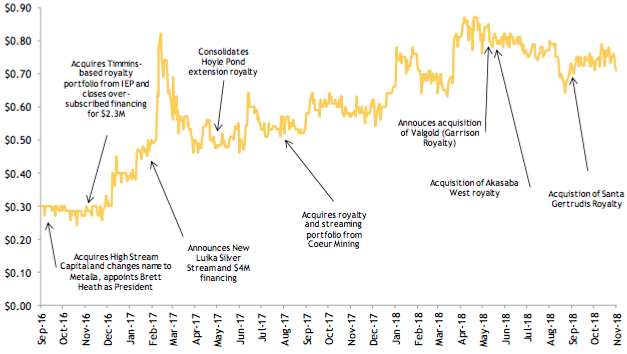
Also, we are expecting a resource update in January 2019 from Osisko Mining on the Garrison gold property where Metalla has a 2% NSR royalty. Osisko has drilled an additional 90,000 m since the latest PEA (the PEA has just under 2 million ounces of gold resources). We are expecting a significant improvement in total ounces, but also an improvement in the categories of Measured & Indicated.
Finally, the Joaquin project which is being developed by Pan American Silver, where Metalla owns a 2% NSR continues to show progress. Pan American has stated that they now expect production in Q1 of 2020.
The Santa Gertrudis deal puts your market cap above C$80 M. At what stage might a mid-tier precious metals Royalty & Streaming company like Sandstorm Gold (~C$1 billion market cap), or Maverix Metals (~C$515 M market cap) show interest in acquiring Metalla?
The bigger royalty companies historically look to take over smaller royalty companies when gold & silver enter into a bull market. This is because mining company equity often becomes over-valued, making it is less costly to acquire a company like Metalla outright rather than take on a royalty or stream. Bigger royalty companies that trade at much higher valuations can provide big premiums to smaller royalty companies while still being accretive.
One of the biggest problems the big royalty companies have in a bull market in precious metals is growth. That’s because providing project capital to mining companies usually gives them a 2-3 year window for those projects to come online. They are forced to look at buying companies like Metalla or price royalties or streams at a much higher cost. Historically that hasn’t worked out so well.
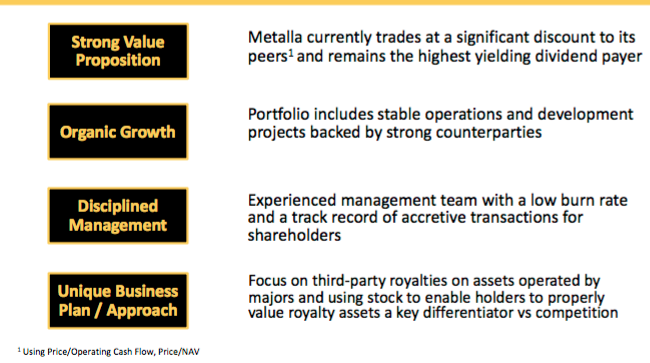
A crucial part of our portfolio is royalties on development projects with major mining companies. We think these assets will command a large premium in the future, potentially even more than our royalties that are already producing.
Silver & Gold prices (in USD) have been weak this year, down 16% & 6%, respectively, how much is that likely to impact your FY 2019 earnings (for the year ending May 2019)?
We take metal price risk along with the mining companies, specifically on silver where 100% of our cash flow comes from currently. What is important to remember is that royalty & streaming contracts offer guaranteed margins. So where a mining company may be break even or losing money at a slightly lower gold or silver price, Metalla will always have cash flow as long as the asset is in production. More importantly, when precious metals prices rise, there is a tremendous amount of leverage built in that translates directly to the shareholders of Metalla.
On the other hand, lower precious metals prices might enable Metalla to strike better deal terms, do you see more attractive transaction opportunities?
We are looking to lock up as much gold and silver in royalty & streaming contracts as we can at current prices. These are the times when incredible deals can be struck, and, as an investor of Metalla, we pay you to wait through our monthly dividend program.
What can you tell readers about new deals that you’re actively working on, deals that could be announced within the next 6 months?
I can tell readers that the hardest part of building a royalty company is getting to a place of critical mass. I believe we have achieved this in the first two years at Metalla and I think it will be easier to scale this company from C$80M to C$500M than it was to go from C$0 – C$80M. Now is the time to position for the next cycle before the institutions take notice of what we have built.
Your current annualized distribution yield is 2.25% (based on C$0.80 stock price), the highest of any precious metals-focused Royalty/Streamer I know of. As the company grows, what are the implications for monthly distributions over the next 6-12 months?
We hope to bring on some royalties that are currently producing over the next 6 months. If we do, the development pipeline could allow us to enhance our dividend program. We have stated a 50% dividend payout goal, but we are prudently working our way towards that goal.
In terms of company valuation, how does Metalla compare to peers? What metrics do you use in your comparisons?
We still trade at a steep discount to peers based on a Net Asset Value (NAV) perspective. As we grow Metalla to C$100M+ in market cap, we expect investment banks to pick up research coverage of us showing the deep value Metalla has to offer. This could be a big potential catalyst for shareholders over the coming year.
Why should readers consider buying shares of Metalla Royalty & Streaming Ltd. instead of other precious metals companies?
We have a strategy, focusing on the pre-existing royalty market that has allowed up to excel in what is a very competitive industry. As a first mover, this should continue to translate into outperformance among our peers.
Thank you again Brett for your time and thoughtful responses to my questions.
Disclosures: The content of this interview is for illustrative and information purposes only. Readers fully understand and agree that nothing contained herein, written by Peter Epstein of Epstein Research, [ER] including but not limited to, commentary, opinions, views, assumptions, reported facts, estimates, calculations, etc. is to be considered implicit or explicit, investment advice. Further, nothing contained herein is a recommendation or solicitation to buy or sell any security. Mr. Epstein and [ER] are not responsible for investment actions taken by the reader. Mr. Epstein and [ER] have never been, and are not currently, a registered or licensed financial advisor or broker/dealer, investment advisor, stockbroker, trader, money manager, compliance or legal officer, and they do not perform market making activities. Mr. Epstein and [ER] are not directly employed by any company, group, organization, party or person. Shares of Metalla Royalty & Streaming are speculative, not suitable for all investors. Readers understand and agree that investments in small cap stocks can result in a 100% loss of invested funds. It is assumed and agreed upon by readers that they consult with their own licensed or registered financial advisors before making investment decisions.
At the time this article was posted, Peter Epstein owned shares in Metalla Royalty & Streaming, and the Company was an advertiser on [ER]. By virtue of ownership of the Company’s shares and it being an advertiser on [ER], Peter Epstein is biased in his views on the Company. Readers understand and agree that they must conduct their own research, above and beyond reading this article. While the author believes he’s diligent in screening out companies that are unattractive investment opportunities, he cannot guarantee that his efforts will (or have been) successful. Mr. Epstein & [ER] are not responsible for any perceived, or actual, errors including, but not limited to, commentary, opinions, views, assumptions, reported facts & financial calculations, or for the completeness of this article. Mr. Epstein & [ER] are not expected or required to subsequently follow or cover events & news, or write about any particular company or topic. Mr. Epstein and [ER] are not experts in any company, industry sector or investment topic.
November 27, 2018
- The next Fed meet (and rate hike) is December 19, and just weeks after that, U.S. president Donald “The Golden Trumpster” Trump may be set to unleash a new round of inflationary and growth-crushing tariffs.
- It’s not easy (to put it mildly) for American business to create new factories to replace the products made by highly productive Chinese factories.
- So, for 2019, most top U.S. bank economists and money managers are slashing their U.S. GDP growth forecasts and raising their inflation forecasts.
- Morgan Stanley’s global stock market weightings are legendary in the institutional world, and they just moved America to a horrifying “underweight” ranking for their global stock market positioning.
- Most big-name economists in America see U.S. GDP growth sliding to sub 2% by mid 2019 while inflation stages an “upside surprise”.
- Please click here now. Goldman’s top economists clearly have the same view I do.
- What’s particularly interesting about this forecast is that their top economist is also forecasting four rate hikes from the Fed in 2019.
- Four hikes would put enormous pressure on the U.S. government’s ability to finance its outrageous debt. It can be argued that these hikes are the Fed’s response to the insane growth of that debt.
- Whether there are two rate hikes as Morgan Stanley predicts, three as I predict, or four as Goldman predicts, the growth of U.S. government debt is clearly going to put vastly more pressure on the US government bond market (and the corporate bond market) in 2019 than it already has in 2018.
- In the matter of “tax loss” season, I realize that many gold market investors are nervous that gold stocks will decline into December like they have in recent years.
- Please click here now. Double-click to enlarge. I don’t see anything to be concerned about on this daily gold chart.
- Please click here now. Double-click to enlarge. I don’t see anything on this GDX chart to be concerned about either.
- GDX and most senior gold stocks are tracking the gold price quite nicely. Gold supply is limited, and top analysts at Goldman and other firms are predicting “Commodities will soar.”
- Also, 2019 is an election year in India. Morgan Stanley just raised India to “overweight” in its global stock market weightings, as it moved America to that somewhat pathetic underweight ranking. While GDP growth nosedives to potentially under 2% in America, it should be at least 7% in India for 2019, and I’m predicting it could hit 8%. GDP growth and upside action in the Indian stock market is good news for gold. The bottom line:
- Gold demand in India is rock solid, as it is in China. As commodities begin to rise, Goldman will lead institutional investors into more commodities investing. Gold, GDX, GDXJ, SIL, and related stocks should have a great year.
- Please click here now. Double-click to enlarge this CDNX venture index chart.
- Whether it’s MACD, moving averages, RSI, or a host of other technical indicators, gold and GDX look solid. Unfortunately, that’s not the case with CDNX.
- Please click here now. That’s a look at the key buy (green) and sell (gold) signals for the high risk venture sector that I cover in my gracelandjuniors.com newsletter.
- The CDNX and related stocks are susceptible to tax loss selling. Penny stocks are high risk (but also high potential reward) and I don’t expect to get a major buy signal for the CDNX index until gold trades at $1420 on a weekly closing basis.
- Please click here now. Double-click to enlarge what just may be the world’s most spectacular price chart!
- Barrick is chaired by former Goldman president John Thornton. Thornton has aggressively bought stock in the open market and has categorically stated that he is not selling a single one of his shares for short term gain.
- Clearly, Thornton is not playing for peanuts. With the majestic bull wedge and inverse head and shoulders bottom in play, it’s obvious that this man is poised to see himself and all Barrick shareholders gain enormous wealth in what I call the “bull era”.
- Thornton was the driving force of the Barrick-Rangold merger. That merger was approved by a stunning 95% of shareholders of both companies. The Chinese government has awarded him the government’s highest award for a non-Chinese person. Of foreigners who have contributed significantly to Chinese growth, the Chinese government views John Thornton as one of the fifteen most important people in the world.
- Barrick shareholders are not just in good hands. They are in spectacular hands! A breakout from the bull wedge with a Friday close over $14 is a rocket launch signal for the entire gold mining sector. Rather than wasting time worrying about a tax loss season that is going the way of the dodo bird, I suggest that gold stock investors should be positioning themselves, as Goldman clearly is, for the rocket ride of a lifetime, in a fabulous gold bull era!
https://gracelandupdates.com/subscribe-pp/
Stewart Thomson is a retired Merrill Lynch broker. Stewart writes the Graceland Updates daily between 4am-7am. They are sent out around 8am-9am. The newsletter is attractively priced and the format is a unique numbered point form. Giving clarity of each point and saving valuable reading time.
Risks, Disclaimers, Legal
Stewart Thomson is no longer an investment advisor. The information provided by Stewart and Graceland Updates is for general information purposes only. Before taking any action on any investment, it is imperative that you consult with multiple properly licensed, experienced and qualified investment advisors and get numerous opinions before taking any action. Your minimum risk on any investment in the world is: 100% loss of all your money. You may be taking or preparing to take leveraged positions in investments and not know it, exposing yourself to unlimited risks. This is highly concerning if you are an investor in any derivatives products. There is an approx $700 trillion OTC Derivatives Iceberg with a tiny portion written off officially. The bottom line: Are You Prepared?
The major silver miners’ stocks have been largely abandoned this year, spiraling to brutal multi-year lows. Such miserable technicals have exacerbated the extreme bearishness plaguing this tiny contrarian sector. While profitable silver mining is challenging at today’s exceedingly-low silver prices, these miners are chugging along. Their recently-reported Q3’18 results show their earnings are ready to soar as silver recovers.
Four times a year publicly-traded companies release treasure troves of valuable information in the form of quarterly reports. Companies trading in the States are required to file 10-Qs with the US Securities and Exchange Commission by 40 calendar days after quarter-ends. Canadian companies have similar requirements at 45 days. In other countries with half-year reporting, many companies still partially report quarterly.
Unfortunately the universe of major silver miners to analyze and invest in is pretty small. Silver mining is a tough business both geologically and economically. Primary silver deposits, those with enough silver to generate over half their revenues when mined, are quite rare. Most of the world’s silver ore formed alongside base metals or gold. Their value usually well outweighs silver’s, relegating it to byproduct status.
The Silver Institute has long been the authority on world silver supply-and-demand trends. It published its latest annual World Silver Survey covering 2017 in mid-April. Last year only 28% of the silver mined around the globe came from primary silver mines! 36% came from primary lead/zinc mines, 23% copper, and 12% gold. That’s nothing new, the silver miners have long produced less than a third of world mined supply.
It’s very challenging to find and develop the scarce silver-heavy deposits supporting primary silver mines. And it’s even harder forging them into primary-silver-mining businesses. Since silver isn’t very valuable, most silver miners need multiple mines in order to generate sufficient cash flows. Traditional major silver miners are increasingly diversifying into gold production at silver’s expense, chasing its superior economics.
So there aren’t many major silver miners left out there, and their purity is shrinking. The definitive list of these companies to analyze comes from the most-popular silver-stock investment vehicle, the SIL Global X Silver Miners ETF. In mid-November at the end of Q3’s earnings season, SIL’s net assets were running 6.6x greater than its next-largest competitor’s. So SIL continues to dominate this tiny niche contrarian sector.
While SIL has its flaws, it’s the closest thing we have to a silver-stock index. As ETF investing continues to eclipse individual-stock picking, SIL inclusion is very important for silver miners. It grants them better access to the vast pools of stock-market capital. Differential SIL-share buying by investors requires this ETF’s managers to buy more shares in its underlying component companies, bidding their stock prices higher.
In mid-November as the silver miners were finishing reporting their Q3’18 results, SIL included 23 “Silver Miners”. Unfortunately the great majority aren’t primary silver miners, most generate well under half their revenues from silver. That’s not necessarily an indictment against SIL’s stock picking, but a reflection of the state of this industry. There aren’t enough significant primary silver miners left to fully flesh out an ETF.
This disappointing reality makes SIL somewhat problematic. The only reason investors would buy SIL is they want silver-stock exposure. But if SIL’s underlying component companies generate just over a third of their sales from silver mining, they aren’t going to be very responsive to silver price moves. And most of that ETF capital intended to go into primary silver miners is instead diverted into byproduct silver miners.
So silver-mining ETFs sucking in capital investors thought they were allocating to real primary silver miners effectively starves them. Their stock prices aren’t bid high enough to attract in more investors, so they can’t issue sufficient new shares to finance big silver-mining expansions. This is exacerbating the silver-as-a-byproduct trend. Only sustained much-higher silver prices for years to come could reverse this.
Silver miners’ woes are really exacerbated by silver’s worst performance in decades. In mid-November silver sunk to a 2.8-year low of $13.99. That naturally dragged down SIL to a similar 2.7-year low. But relative to gold which usually drives it, silver was faring far worse. The Silver/Gold Ratio sunk to 85.9x in mid-November, meaning it took almost 86 ounces of silver to equal the value of a single ounce of gold.
The SGR hadn’t been lower, or silver hadn’t been more undervalued relative to gold, since all the way back in March 1995! That’s pretty much forever from a markets perspective. With silver languishing at an exceedingly-extreme 23.7-year low relative to gold, it’s hard to imagine it doing much worse. So the silver miners are weathering one of the toughest environments they’ve ever seen, which we have to keep in mind.
Every quarter I dig into the latest results from the major silver miners of SIL to get a better understanding of how they and this industry are faring fundamentally. I feed a bunch of data into a big spreadsheet, some of which made it into the table below. It includes key data for the top 17 SIL component companies, an arbitrary number that fits in this table. That’s a commanding sample at 96.9% of SIL’s total weighting!
While most of these top 17 SIL components had reported on Q3’18 by mid-November, not all had. Some of these major silver miners trade in the UK or Mexico, where financial results are only required in half-year increments. If a field is left blank in this table, it means that data wasn’t available by the end of Q3’s earnings season. Some of SIL’s components also report in gold-centric terms, excluding silver-specific data.
The first couple columns of this table show each SIL component’s symbol and weighting within this ETF as of mid-November. While most of these stocks trade on US exchanges, some symbols are listings from companies’ primary foreign stock exchanges. That’s followed by each miner’s Q3’18 silver production in ounces, along with its absolute year-over-year change. Next comes this same quarter’s gold production.
Nearly all the major silver miners in SIL also produce significant-to-large amounts of gold! That’s truly a double-edged sword. While gold really stabilizes and boosts silver miners’ cash flows, it also retards their stocks’ sensitivity to silver itself. So the next column reveals how pure these elite silver miners are, approximating their percentages of Q3’18 revenues actually derived from silver. This is calculated two ways.
The large majority of these top SIL silver miners reported total Q3 revenues. Quarterly silver production multiplied by silver’s average price in Q3 can be divided by these sales to yield an accurate relative-purity gauge. When Q3 sales weren’t reported, I estimated them by adding silver sales to gold sales based on their production and average quarterly prices. But that’s less optimal, as it ignores any base-metals byproducts.
Next comes the major silver miners’ most-important fundamental data for investors, cash costs and all-in sustaining costs per ounce mined. The latter directly drives profitability which ultimately determines stock prices. These key costs are also followed by YoY changes. Last but not least the annual changes are shown in operating cash flows generated and hard GAAP earnings, with a couple exceptions necessary.
Percentage changes aren’t relevant or meaningful if data shifted from positive to negative or vice versa, or if derived from two negative numbers. So in those cases I included raw underlying data rather than weird or misleading percentage changes. This whole dataset together offers a fantastic high-level read on how the major silver miners are faring fundamentally as an industry. They are hanging in there quite well.
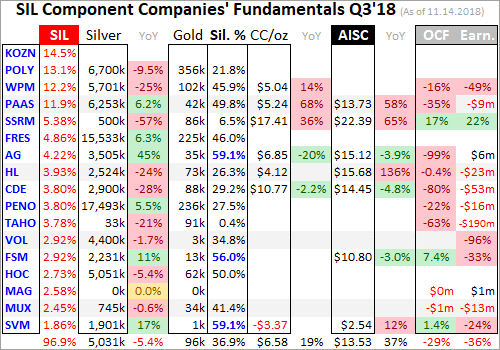
Production is naturally the lifeblood of the silver-mining sector. The more silver and increasingly gold that these elite miners can wrest from the bowels of the earth, the stronger their fundamental positions and outlooks. These top 17 SIL miners’ overall silver production slipped 2.2% YoY to 75.5m ounces in Q3’18. But their shift into more-profitable gold mining continued, with aggregate production up 1.6% YoY to 1.4m ounces.
According to the Silver Institute’s latest WSS, total world silver mine production averaged 213.0m ounces per quarter in 2017. So at 75.5m in Q3, these top 17 SIL components were responsible for 35.4% of that rate. There is one unusual situation that slightly skewed this result. SSR Mining, which used to be known as Silver Standard Resources, saw its silver production plummet 57% YoY as its lone silver mine is depleting.
The winding down of SSRM’s old Pirquitas silver mine is proceeding as forecast and has been going on for some time. This once major silver miner is morphing into a primary gold miner, which accounted for a record 94% of its revenue in Q3. Excluding SSRM, the rest of these top SIL silver miners saw their silver production retreat an immaterial 1.3% YoY. That’s pretty impressive given this year’s collapse in silver prices.
Q3’s average silver price was just $14.96, down a major 11.2% YoY. That was far-worse performance than gold, with its quarterly average merely sliding 5.3% lower between Q3’17 to Q3’18. Considering how miserable this silver-price environment is with the worst relative performance to gold in decades, the major silver miners are doing well on production. They continue to hold out for silver mean reverting higher.
Silver is likely so down in the dumps because it effectively acts like a gold sentiment gauge. Generally big silver uplegs only happen after gold has rallied long enough and high enough to convince traders its gains are sustainable. Then the way-smaller silver market tends to start leveraging and amplifying gold’s moves by 2x to 3x. But gold sentiment was so insipid over this past year that no excitement was sparked for silver.
Unfortunately at these bombed-out silver prices the economics of silver mining are way inferior to gold mining. The traditional major silver miners are painfully aware of this, and have spent years actively diversifying into gold. In Q3’18, the average percentage of revenues that these top 17 SIL miners derived from silver was just 36.9%. That’s right in line with the prior 4 quarters’ 39.3%, 35.3%, 36.8%, and 36.3%.
Silver mining is every bit as capital-intensive as gold mining, requiring similar large expenses for planning, permitting, and constructing mines and mills. It needs similar heavy excavators and haul trucks to dig and move the silver-bearing ore. Similar levels of employees are necessary to run these mines. But silver generates much lower cash flows due to its lower price. Consider hypothetical mid-sized silver and gold mines.
They might produce 10m and 300k ounces annually. At last quarter’s average prices, these silver and gold mines would yield $150m and $363m of yearly sales. Thus regrettably it is far easier to pay the bills mining gold these days. So primary silver miners are increasingly becoming a dying breed, which is sad. The traditional major silver miners are adapting by ramping their gold production often at silver’s expense.
With major silver miners so rare, SIL’s managers are really struggling to find components for their leading ETF. So in Q3’17 they added Korea Zinc, which is now SIL’s largest component at over 1/7th of its total weighting. In my decades of studying and trading this tiny sector, I’d never heard of it. So I looked into Korea Zinc and found it was merely a smelter, not even a miner. It really needs to be kicked out of SIL.
Every quarter since I’ve tried to dig up information on Korea Zinc, but its English-language disclosures are literally the worst I’ve ever seen for any company. Its homepage gives an idea of what to expect, declaring “We are Korea Zinc, the world’s one of the best smelting company”. I’ve looked and looked and the latest production data I can find in English remains 2015’s. I can’t find it from third-party sources either.
That year Korea Zinc “produced” 63.3m ozs of silver, which averages to 15.8m quarterly. That is largely a byproduct from its main businesses of smelting zinc, lead, copper, and gold. Korea Zinc certainly isn’t a major silver miner, and has no place in a “Silver Miners ETF”. No silver-stock investor wants to own a base-metals smelter! Korea Zinc should be removed, its overweighting reallocated to the rest of SIL’s holdings.
SIL investors ought to contact Global X to ask them to stop tainting their ETF’s utility and desirability with Korea Zinc. If they want it to be successful and grow, they need to stick with their mission of owning the major silver miners exclusively. Silver-stock exposure is the only reason investors would buy SIL. There is another situation investors need to be aware of with Tahoe Resources and its held-hostage Escobal mine.
Tahoe was originally spun off by Goldcorp to develop the incredible high-grade Escobal silver mine in Guatemala, which went live in Q4’13. Everything went well for its first few years. By Q1’17, Escobal was a well-oiled machine producing 5700k ounces of silver. That provided 1000+ great high-paying jobs to locals and contributed big taxes to Guatemala’s economy. Escobal was a great economic boon for this country.
But a radical group of anti-mining activists managed to spoil everything, cruelly casting their fellow countrymen out of work. They filed a frivolous and baseless lawsuit against Guatemala’s Ministry of Energy and Mines, Tahoe wasn’t even the target! It alleged this regulator hadn’t sufficiently consulted with the indigenous Xinca people before granting Escobal’s permits. They don’t even live around this mine site.
Only in a third-world country plagued with rampant government corruption would a regulator apparently not holding enough meetings be a company’s problem. Instead of resolving this, a high Guatemalan court inexplicably actually suspended Escobal’s mining license in early Q3’17! Tahoe was forced to temporarily mothball its crown-jewel silver mine, and thus eventually lay off its Guatemalan employees.
That license was technically reinstated a couple months later, but the activists appealed to a higher court. It required the regulator to study the indigenous people in surrounding areas and report back, and then needs to make a decision. The government also needs to clear out an illegal roadblock to the mine site by violent anti-mine militants, who have blockaded Escobal supplies and physically attacked trucks and drivers!
So Escobal has been dead in the water with zero production for 5 quarters now, an unthinkable outcome. This whole thing is a farce, a gross miscarriage of justice. I hope this isn’t a stealth expropriation, that Guatemalan bureaucrats will get their useless paperwork done sooner or later and let Escobal come back online. Within a year, Escobal’s silver production should return to pre-fiasco levels of 5700k ounces a quarter.
At that rate, Escobal would retake the throne of being the world’s largest primary silver mine! It would boost overall SIL-top-17 production by a massive 7.6%. Last year no one expected this unprecedented Escobal debacle to last very long, as the economic damage to Guatemala was too great. But as it drags on and on, TAHO stock has been decimated. It slumped to a brutal all-time record low in mid-November.
Sadly for long-suffering TAHO shareholders, management capitulated. In mid-November they agreed to sell the company to Pan American Silver at rock-bottom prices despite a 55% premium over that all-time low. That’s devastating for TAHO investors but a steal for PAAS, which is SIL’s 4th-largest component at 11.9% of its total weighting. That keeps Escobal’s huge production in SIL if PAAS can finesse its reopening.
Unfortunately SIL’s mid-November composition was such that there wasn’t a lot of Q3 cost data reported by its top component miners. A half-dozen of these top SIL companies trade in South Korea, the UK, Mexico, and Peru, where reporting only comes in half-year increments. There are also primary gold miners that don’t report silver costs, and a silver explorer with no production. So silver cost data remains scarce.
Nevertheless it’s always useful to look at what we have. Industrywide silver-mining costs are one of the most-critical fundamental data points for silver-stock investors. As long as the miners can produce silver for well under prevailing silver prices, they remain fundamentally sound. Cost knowledge helps traders weather this sector’s left-for-dead unpopularity without succumbing to selling low like the rest of the herd.
There are two major ways to measure silver-mining costs, classic cash costs per ounce and the superior all-in sustaining costs. Both are useful metrics. Cash costs are the acid test of silver-miner survivability in lower-silver-price environments, revealing the worst-case silver levels necessary to keep the mines running. All-in sustaining costs show where silver needs to trade to maintain current mining tempos indefinitely.
Cash costs naturally encompass all cash expenses necessary to produce each ounce of silver, including all direct production costs, mine-level administration, smelting, refining, transport, regulatory, royalty, and tax expenses. In Q3’18, these top 17 SIL-component silver miners that reported cash costs averaged $6.58 per ounce. While that surged 35.3% YoY, it still remains far below today’s anomalously-low silver prices.
There are a couple of extreme cash-cost outliers that are skewing this average, but offsetting each other. SSRM’s depleting silver mine is producing less with each passing quarter, forcing fewer ounces to bear the fixed costs of mining. Its crazy-high $17.41 per ounce in Q3 isn’t normal. But on the other side of this is Silvercorp Metals, which produces silver in Chinese mines yielding enormous base-metals byproducts.
Selling those and crediting their value across the silver ounces mined dragged down SVM’s cash costs to an unbelievable negative $3.37 in Q3! Excluding these extreme outliers, the rest of the SIL top 17 saw average cash costs of $6.40. That’s not too far above the past 4 quarters’ $4.86, $4.66, $5.05, and $3.95. As long as silver prices remain over those low levels, the silver miners can keep the lights on at their mines.
Way more important than cash costs are the far-superior all-in sustaining costs. They were introduced by the World Gold Council in June 2013 to give investors a much-better understanding of what it really costs to maintain silver mines as ongoing concerns. AISCs include all direct cash costs, but then add on everything else that is necessary to maintain and replenish operations at current silver-production levels.
These additional expenses include exploration for new silver to mine to replace depleting deposits, mine-development and construction expenses, remediation, and mine reclamation. They also include the corporate-level administration expenses necessary to oversee silver mines. All-in sustaining costs are the most-important silver-mining cost metric by far for investors, revealing silver miners’ true operating profitability.
In Q3’18 these top 17 SIL miners reporting AISCs averaged $13.53 per ounce, which also surged 39.0% YoY. Again that was skewed in both directions by SSRM’s extremely-high $22.39 on Pirquitas’ depletion and SVM’s exceedingly-low $2.54 on those huge base-metals byproducts. Without them, the rest of the top 17 averaged $13.96 AISCs. That was much higher than the past 4 quarters’ $9.73, $10.16, $10.92, and $10.93.
The lower production was definitely a factor, which is inversely proportional to per-ounce costs. Silver-mining costs are largely fixed quarter after quarter, with actual mining requiring roughly the same levels of infrastructure, equipment, and employees. So the lower production, the fewer ounces to spread mining’s big fixed costs across. The major silver miners also reported lower ore grades, exacerbating the decline.
Nevertheless, the top 17 SIL miners’ AISCs both with and without the outliers still remained under silver’s weak average $14.96 price in Q3. So even with silver faring its worst relative to gold in decades thanks to devastated sentiment, the silver mines were profitable. And interestingly the closer AISCs crowd the prevailing silver prices, the more profits leverage the miners have to silver mean reverting much higher.
In mid-November silver and SIL slumped to their lowest levels since back in January and March 2016. That was early in a new silver bull which emerged from conditions like today’s where silver was despised. Over 7.6 months between December 2015 and August 2016, silver soared 50.2% higher as gold surged in its own new bull. And with silver moving again, investors eagerly started returning to the battered silver stocks.
Thanks to that silver-bull upleg, SIL skyrocketed 247.8% higher in just 6.9 months in essentially that first half of 2016! That ought to give embattled silver-stock investors some hope. All it will take to turn silver stocks around is a typical gold-driven silver upleg, and then they will soar again. The reason that silver miners’ stocks blast dramatically higher with silver is their high inherent profits leverage to silver prices.
Assume another 50% silver upleg, which is pathetically small by historical standards, from silver’s recent secular low in mid-November. That would catapult silver back up to $21 per ounce for the first time since July 2014. At Q3’18’s top-17-SIL-stock average AISCs of $13.53, profits were just $0.47 per ounce at $14 silver. But at $21 assuming stable AISCs, they would soar an astounding 1489% higher to $7.47 per ounce!
You better believe silver-stock prices would skyrocket with that kind of earnings growth. The higher their AISCs, the greater their upside profits leverage. Now consider this same 50% silver upleg using the rolling-past-4-quarter top-17-SIL-stock average AISCs of $10.43 per ounce. That implies the $3.57 profit seen at $14 silver would only balloon 196% to $10.57 per ounce at $21 silver. So higher costs aren’t necessarily bad.
As long as AISCs are below prevailing silver prices, the major silver miners can weather anything. The closer their AISCs creep to silver, the greater their earnings growth when silver mean reverts higher. So the major silver miners’ upside from here is truly explosive as silver recovers, just like back in early 2016. And silver will power much higher soon as the record silver-futures shorts of early September continue to be covered.
While all-in sustaining costs are the single-most-important fundamental measure that investors need to keep an eye on, other metrics offer peripheral reads on the major silver miners’ fundamental health. The more important ones include cash flows generated from operations, GAAP accounting profits, revenues, and cash on hand. As you’d expect given the miserably-low silver prices, they were on the weak side in Q3.
Operating cash flows among these SIL top 17 reporting them fell 23.0% YoY to $830m, which is totally reasonable given the 2.2%-lower silver production and 11.2%-lower average silver prices. Sales fell 9.5% YoY to $2717m, with some of the silver-side weakness offset by the 1.6%-higher gold production. And cash on hand fell 9.8% YoY to a still-hefty $2419m, giving these silver miners plenty of capital to weather this storm.
The hard GAAP accounting profits looked pretty ugly though, plunging to a $243m loss from being $88m in the black in Q3’17. But most of those losses didn’t reflect operations. TAHO alone wrote off a massive $170m for the impairment of Escobal, which reflected an estimated restart date of the end of 2019. Coeur Mining reported a smaller $19m writedown for one of its mines. These two non-cash charges alone were $189m.
Without them GAAP profits would’ve sunk from $88m in Q3’17 to a milder $54m loss in Q3’18. That’s still poor, but not unexpected given the lowest silver prices seen in almost several years. Again silver-mining earnings will soar if not skyrocket as silver inevitably mean reverts higher from here. All it takes for silver to surge in major bull-market uplegs is for gold itself to power higher, and huge gold upleg fuel abounds now.
The silver-mining stocks are doing way better fundamentally than they’ve been given credit for. Their higher Q3’18 mining costs still remained below the recent deep silver lows. And the compressed gap between their AISCs and low prevailing silver prices guarantees epic profits upside as silver recovers and mean reverts higher. That will attract back investors fast, catapulting silver stocks up sharply like in early 2016.
While traders can play that in SIL, this ETF has problems. Its largest component is now a base-metals smelter of all things! And the great majority of its stocks are primary gold miners with byproduct silver production. The best gains by far will be won in smaller purer mid-tier and junior silver miners with superior fundamentals. A carefully-handpicked portfolio of these miners will generate much-greater wealth creation.
The key to riding any silver-stock bull to multiplying your fortune is staying informed, both about broader markets and individual stocks. That’s long been our specialty at Zeal. My decades of experience both intensely studying the markets and actively trading them as a contrarian is priceless and impossible to replicate. I share my vast experience, knowledge, wisdom, and ongoing research through our popular newsletters.
Published weekly and monthly, they explain what’s going on in the markets, why, and how to trade them with specific stocks. They are a great way to stay abreast, easy to read and affordable. Walking the contrarian walk is very profitable. As of Q3, we’ve recommended and realized 1045 newsletter stock trades since 2001. Their average annualized realized gains including all losers is +17.7%! That’s double the long-term stock-market average. Subscribe today and take advantage of our 20%-off holidays sale!
The bottom line is the major silver miners’ fundamentals remain solid based on their recently-reported Q3’18 results. They continue to mine silver at all-in sustaining costs below even mid-November’s deep silver lows. Their profits will multiply dramatically as silver rebounds higher driven by gold’s own upleg and record silver-futures short covering. Investment capital will flood back in, catapulting silver stocks up violently.
So traders need to look through the recent forsaken herd sentiment to understand the silver miners’ hard fundamentals. These left-for-dead stocks are seriously undervalued even at today’s low silver prices, let alone where silver heads during the next major gold upleg. Silver can’t languish at extreme anomalous multi-decade lows relative to gold for long. And once it catches a bid, silver stocks will really amplify its upside.
Adam Hamilton, CPA
November 23, 2018
Copyright 2000 – 2018 Zeal LLC (www.ZealLLC.com)
This week, an in-depth article featuring prominent mining executive and Chairman of the Augusta Group of Companies, Richard Warke. Featuring commentary from Barrick Gold Corp.’s Kevin Thomson and Ross Beaty, the article details Richard Warke’s rise in the resource industry, from his sale of Arizona Mining Inc. this summer to his breakout sale of Ventana Gold in 2011 to Eike Batista.
Read the full story here.
By Daniel Cook
Part 2: It’s Only Natural…
Every mining company has the same problem, they’ve got to replenish their inventory every year. That means if they’re mining 100,000 ounces of gold annually they need to discover at least 100,000 ounces every year to stay afloat. Analysts and investors demand it and watch these inventory levels closely.
- Did you know SSR Mining’s most profitable operation could run out of gold reserves in 7 years or less?
- Did you know they just spent $337 million buying that mine (Seabee) in 2016?
- Did you know Seabee now accounts for approximately 39% of SSR Mining’s total cash flow and arguably one third of their $1.7 billion market cap?
Imagine if SSR Mining (SSRM, TSX) wasn’t able to find more gold before their reserves run out at Seabee, not enough to sustain production of +100,000 ounces per year anyway, and the negative impact it could have on the Company’s long-term growth plans (SSRM would take a negative hit too).
It’s a legitimate concern, but as a shareholder of SSR Mining you shouldn’t have to worry about that scenario because of the option agreement they signed recently with a little known microcap explorer called Taiga Gold (TGC, CSE).
*Editor’s Note: Taiga is the latest of what’s becoming a tradition of successful spinoffs from Eagle Plains (EPL, TSX-V)

Taiga Gold Staff visiting the Seabee Gold Operation
Here’s the deal…
Taiga Gold has granted SSR Mining an opportunity to earn up to an 80% interest in the 34,000 hectare Fisher property by completing $4 million exploration expenditures and making $3.3 million in cash payments to Taiga Gold.
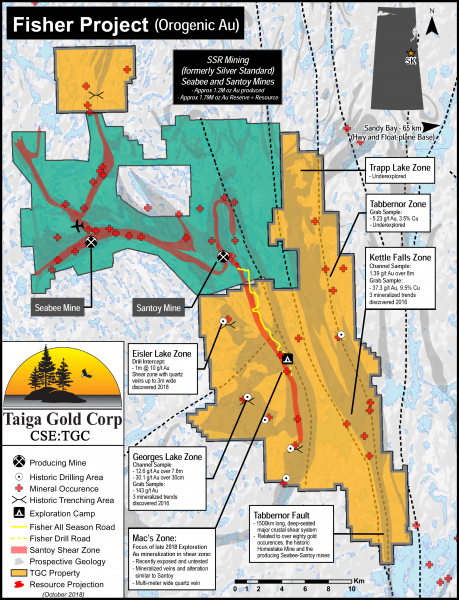
Looking at the map you can see this isn’t what some might call “closeology” in a derogatory way.
Taiga’s Fisher property is close to Seabee in a complimentary way!
In fact, the majority of what SSR Mining has mapped as the “Santoy shear zone” extends onto Fisher.
Think about that…
According to SSR Mining’s own maps the majority, call it 66%, of the Santoy shear zone extends onto Fisher!
That’s pretty major.
The two properties might as well be one.
This is the same belt of rocks, all underexplored and highly prospective geology for hosting gold deposits. More than 80 gold occurrences including the Homestake Mine and SSR Mining’s Seabee-Santoy mines are situated along the Tabbernor fault, a deep-seated crustal shear system that underlies Fisher for a strike length of 40 kilometres.
Fisher increases SSR Mining’s overall land package in the region by 150%!
Can you see how the Fisher property is majorly important for SSR Mining’s future in Saskatchewan?
Knowing Seabee is SSR Mining’s most profitable mine and it only has roughly 7 years of reserves, maybe less, making new discoveries and adding ounces is crucial.
Early stage exploration work to date includes 1,600 soil samples, 600 rock samples, and 5,200 line km of geophysical data. Highlights being 25 rock samples grading +1 g/t Au and grab sample grading nearly 2 ounces Gold.
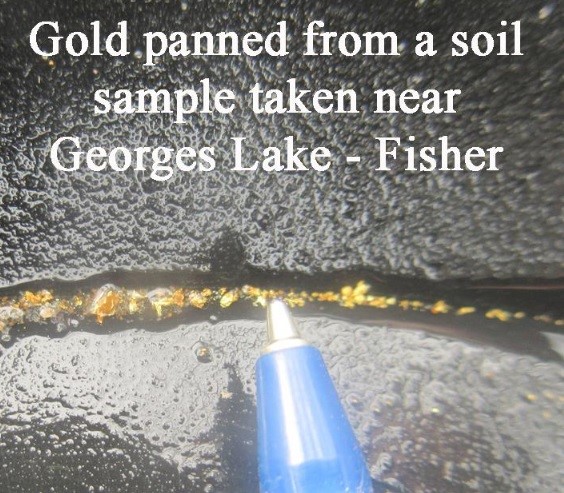
SSR Mining had a field crew of 8 people and 2 drill rigs working on the ground all summer. As of the most recent update 8,550 metres (14 holes) have been completed of a 15,000 metre drill program on Fisher in 2018. Results will be formally announced as they are received, compiled, and interpreted.
Who knows, we don’t have a crystal ball, but could you imagine a $1.7 billion company like SSR Mining being content with 80% ownership?
Assuming they meet their JV obligation by spending $4 million on exploration and give $3.3 million cash to Taiga I could see SSR Mining buying Taiga outright. That’s just my gut talking, but it’s certainly within the realm of possibilities.
Also within the realm of possibilities is that SSR Mining plays to win right away by acquiring Taiga before making a $3 million cash payment. As per the terms of the JV SSR Mining first spends $4 million on exploration to earn 60%, from there they have a one year, one-time option, to earn an additional 20% (for a total of 80%) by making the $3 million cash payment to Taiga.
Either way, both roads lead toward a takeover of Taiga.
If the Fisher property secures their future at Seabee why wouldn’t they make an offer?
SSR Mining is sitting on $493 million worth of cash.
Taiga Gold, at 9 cents per share, has a market cap of $5.4 million.
It’s only natural.
Geologically speaking the Seabee and Fisher properties are essentially one, so they belong together.
About the author: Starting out, Daniel Cook was a stockbroker during his college years. At the age of 23 he founded his own Registered Investment Advisory (RIA) firm. Daniel is a full-time investor and prospector of the markets, constantly digging for exceptional opportunities. Helping those companies get discovered and gain traction in the marketplace is Mr. Cook’s main objective.
By Tina Leto
The odds seem to be against uranium. Fukushima’s nuclear power plant is still disabled; the U.S. Supreme Court seems to be leaning towards staying Virginia’s moratorium on uranium mining, and projects such as Berkeley Energía’s Salamanca mine in Spain are facing major opposition.
So, why mine uranium and why now?
The answer is quite simple, actually. There is increased demand, and, after a period of volatility, prices are going up.
A series of current events are increasing demand and pushing up the value of U308. Bank of America Merrill Lynch commodities team raised its uranium concentrate price estimates for 2018, 2019 and 2020 by 3%, 22% and 32%, respectively.
Cameco CEO Tom Gitzel has a bullish look on uranium but remarked prices still have a long way to go to create some sort of optimism in the market, things are moving forward, even if it is in a slow and steady pace. The current spot price is up 40% from last year and has reached its highest level in over two-and-a-half years at around $28.75/lbs.
So, what is happening?
First, we need to take into account that, nearly eight years after the Great East Japan Earthquake, the resource-poor country has already reactivated five nuclear plants and nine reactors and has approved a 20-year operations extension for the Tokai Daini reactor located some 115 kilometres northeast of central Tokyo.
Although it is unlikely that it achieves it by 2030 as promised by the government, the Land of the Rising Sun is working towards its goal of generating a fifth of its electricity from nuclear plants in the next decade. To achieve this, of course, they will need the raw material, uranium.
Then we have China, whose uranium demand is expected to grow to around 10,800 tonnes by 2020 and rise to between 16,300 tonnes and 18,500 tonnes by 2025. The Xi administration has said it will spend $2.4 trillion to expand its nuclear power generation by 6,600% and in the near term, it plans to connect five reactors to the electricity grid and start building six to eight additional units.
In Southeast Asia, India is carrying out an aggressive growth policy reliant on nuclear power that uses both local and imported uranium. At present, the subcontinent has 22 nuclear reactors, 14 of which use foreign inputs, and it is in the process of finishing up six new units. In the next few years, 19 reactors are expected to be built.
In the Middle East, Saudi Arabia commenced reactor procurement discussions with supplier countries, as it plans to build two large nuclear power reactors and projects 17 GWe of nuclear capacity by 2040 to provide 15% of the kingdom’s power.
Canada, on the other hand, just launched its Small Modular Reactor Roadmap to promote the construction of such infrastructures, which are capable of generating up to 300 MW for small and remote communities and mines that are not connected to the electric grid.
As all of this is happening, supply is starting to see cuts given the decision by Canada’s Cameco to suspend its McArthur River/Key Lake operations in Saskatchewan, the world’s largest uranium mine, and the resolution of Kazakhstan’s state-owned Kazatomprom to lower output by 20% over the next three years as well as perform another 6% production cut over previous expectations.

*image courtesy of Bloomberg
In addition to the reduced supply, Kazatomprom recently sold 8.1 million lbs of its annual production to Yellow Cake, a new uranium holding company that raised $200 million in a London-based IPO and whose management is buying and storing large amounts of the metal in anticipation of higher prices.
Back in March, the World Nuclear Association reported that there are 448 reactors operative and 57 new reactors under construction, 158 reactors planned or on order, and another 351 proposed. The need for uranium is there and it is not going anywhere. Financial advisors believe that global consumption will grow from about 172 million lbs in 2017 to some 190 million lbs in 2019 while a supply gap should be in place by 2022-2023.
The balance seems to be slowly shifting into a deficit for the first time in more than a decade and, on top of all the cuts previously mentioned, the decision of producers like Cameco to buy larger quantities of material from the spot market going forward to fulfill long-term sales contracts will add upward pressure to the prices.
A drill hole away from a game changer
In other words, now is the time to invest in uranium stocks. With three projects underway, Azincourt Energy Corp (TSX.V: AAZ) is betting on a bright nuclear future. The primary focus of the Vancouver-based explorer and developer is its advanced exploration joint-venture with Skyharbour Resources, the 25,000+ ha East Preston Project, located in the Athabasca Basin, Saskatchewan where their team generated new drill targets to follow up after a successful geophysical exploration program.
Azincourt President and CEO Alex Klenman “These targets are similar to NexGen’s Arrow deposit and Cameco’s Eagle Point mine. East Preston is near the southern edge of the western Athabasca Basin, where targets are in a near surface environment without Athabasca sandstone cover.”
This region is gathering a lot of attention lately, especially after Skyharbour’s option partner Orano Canada (formerly Areva) announced recently that it plans to spend $2.22 million over the next year on exploration and drilling programs at the Preston project, which is right next door to the Azincourt/Skyharbour JV on East Preston.
In the next six years, big player Orano may end up investing about $6.04 million on exploration at Preston in exchange for up to 70% of the project. This is a hot zone of exploration with the Preston property and Azincourt/Skyharbour’s East Preston to be drilled at the same time. Who will make the first major discovery is anyone’s guess but, as always, it only takes one drill hole to transition from dwarf to giant.
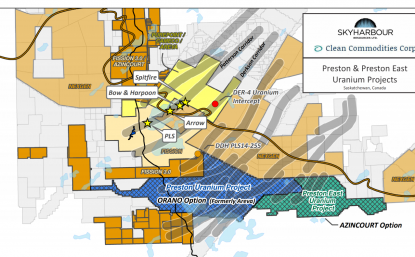
Skyharbour President and CEO Jordan Trimble “Over the past decade, we have seen a number of notable discoveries in the Athabasca Basin. The most notable of which was made by Nexgen Energy, at their Arrow deposit (25 km away from Skyharbour and Azincourt’s East Preston Project) where they have hundreds of millions of lbs of uranium at a high grade and boast a $1B market cap.”
And Azincourt seems to be betting at growing big time in the uranium space. Besides East Preston, the company led by Alex Klenman carries 10% of the Fission 3.0 Patterson Lake North project in Athabasca, and it recently acquired three highly prospective Peruvian-based properties known as the Escalera Group.
The South American project consists of three concessions occupying over 7,400 hectares on the Picotani Plateau, which have yielded historical samples of 6500 ppm uranium and recent samples of 3500 ppm uranium. Escalera is currently undergoing a mapping and sampling program.
According to Azincourt’s management, this latter grassroots play in an emerging uranium district combined the firm’s presence in the world-famous Athabasca basin are the well-founded pillars that boost its confidence in the silvery-white metal.
About the author: Tina Leto is a seasoned Canada-based writer focusing on the resource world.
It is very difficult to pick exact bottoms but there are many tools we can use to help us pinpoint potential bottoms.
You don’t hear technical analysts talk about fundamentals but we do for a reason. Major shifts in the primary trend are supported by fundamental shifts, though they can be very hard to spot until after the fact.
Because of our extensive study of history, we are convinced that precious metals will not begin a real bull market until the Fed stops hiking rates. The data shows that many times (though not every time) the gold stocks bottomed soon after the Fed’s final rate hike.
Yes, we’ve beaten this to death but the point is fundamentals matter.
Moving on, we are going to introduce you to a number of tools and indicators which you can use to spot potential bottoms and turning points on a shorter term basis.
The first and foremost focus should be the price action and the various support and resistance lines that are nearby.
In the chart below, we highlight the support and resistance areas.
For example, GDX last week bounced from support at $18. It faces strong resistance above $20. A loss of $18 would likely lead to a test of support in the $16s. GDXJ meanwhile, bounced from its September low at $26. It faces strong resistance near $30 and if it loses the recent low could test support in the $22-$24 range.
1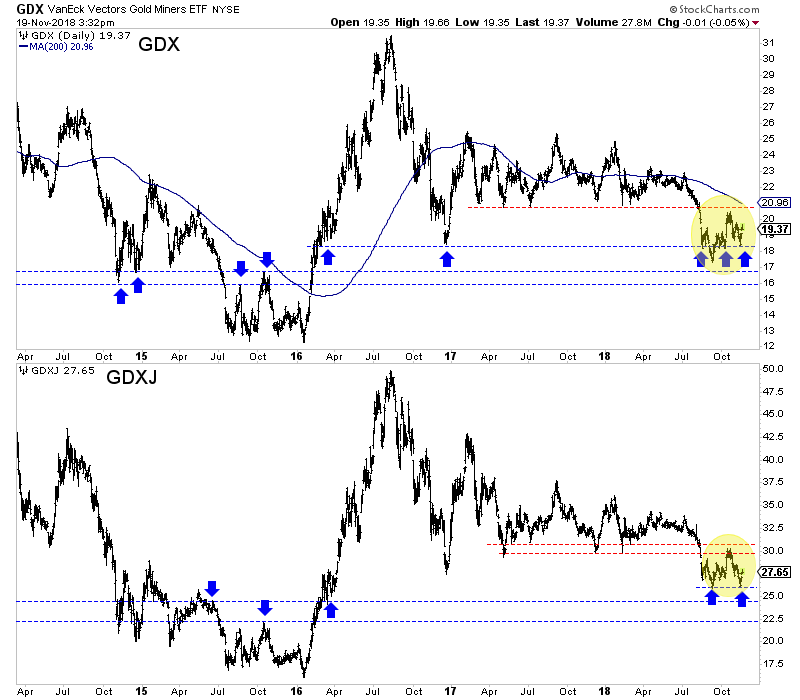
After considering the price action and important support and resistance levels, we turn to the breadth indicators which provide us information in regards to participation and sector divergences.
We plot GDX below along with its advance decline (A/D) line, the bullish percentage index (BPI) and new highs minus new lows.
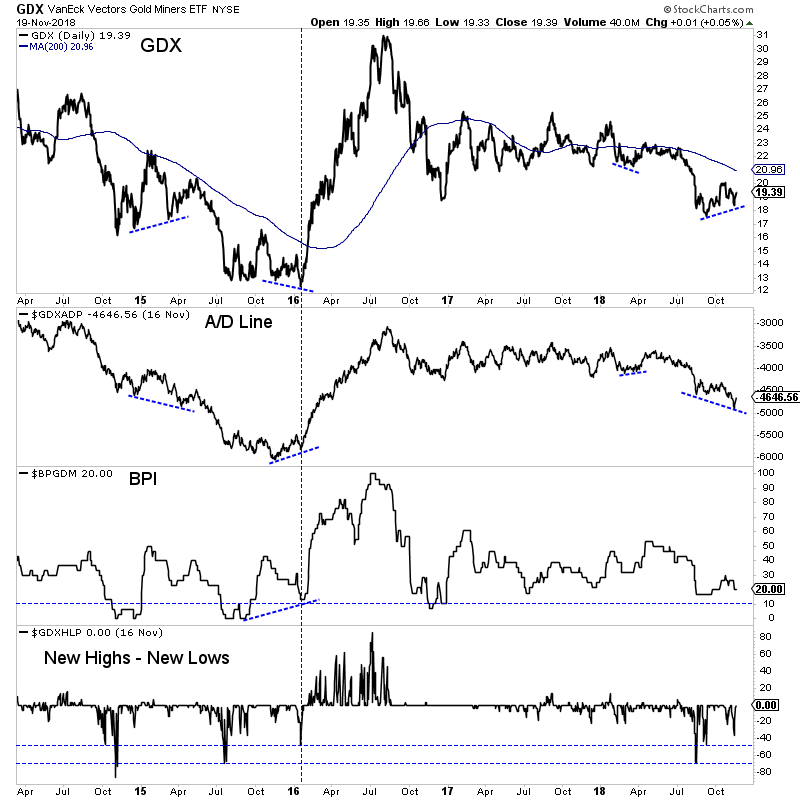
The A/D line, which is one of the most trusted leading indicators is flashing a negative divergence. It looks similar to the one in early 2015. Note that it flashed a major positive divergence in early 2016. Smaller positive divergences were seen in March 2018 and September 2018.
The BPI currently is not telling us much. It needs to fall to 10% for the sector to be considered very oversold.
Days ago the new highs minus new lows indicator hit nearly -40%, which is fairly oversold. In my opinion over -50% or even -70% tends to signal a sustained low as it did in late 2014, summer 2015 and late summer 2018.
Another breadth indicator (and one we custom made for GDXJ) is the percentage of stocks that closed above various moving averages. Below we plot GDXJ along with the percentage of a basket of 55 junior stocks (mostly in GDXJ) that closed above the 20-day moving average, 50-day moving average and 200-day moving average.
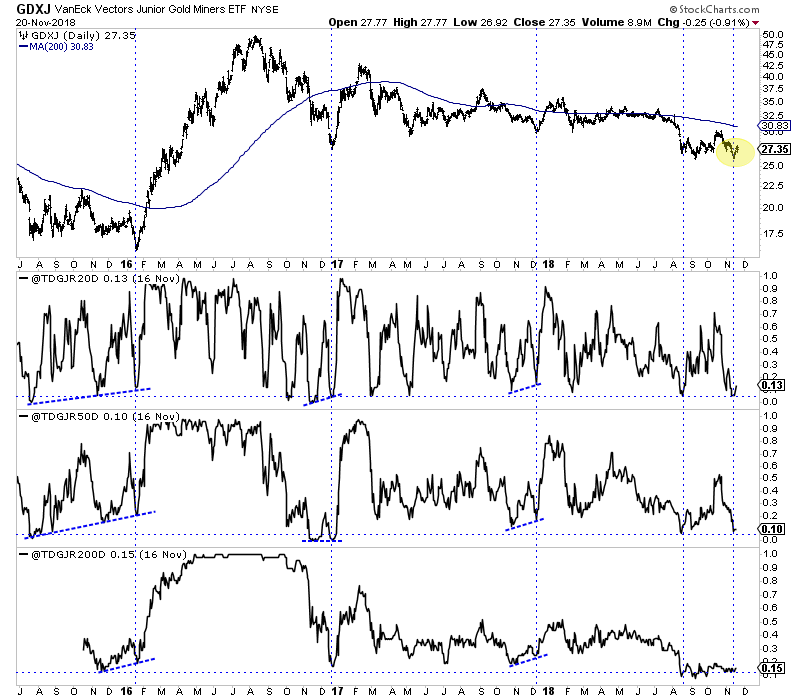
This data showed a strong positive divergence in early 2016 as well in late 2017 and to a lesser degree in late 2016. Last week it showed an oversold condition in GDXJ but no positive divergences.
In addition to breadth indicators, we can also study how the stocks are performing versus the metals and we can track various momentum oscillators.
My two favorite oscillators to study are the rate of change indicator and the distance from the moving average indicator. We plot these in the GDXJ chart below on a 20-day and 50-day basis.
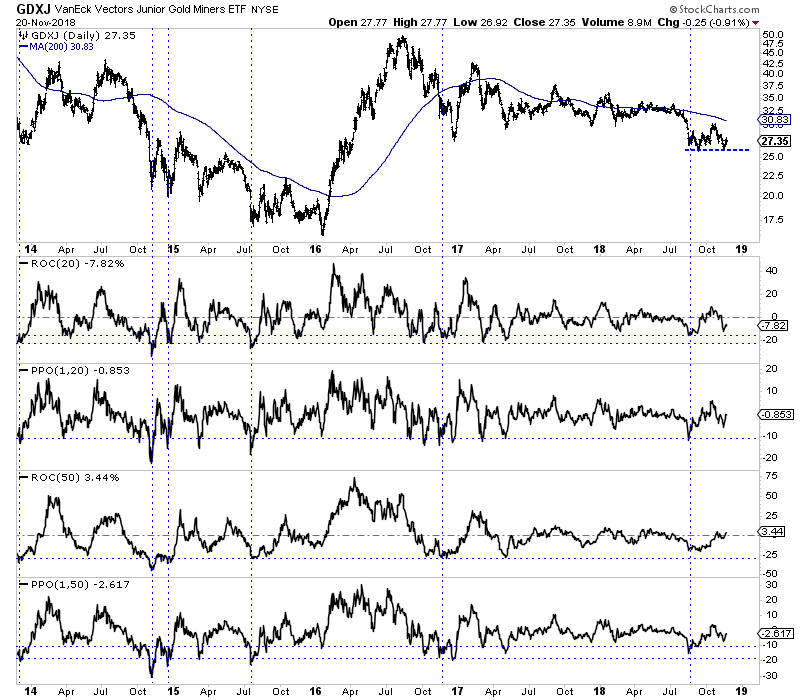
Note that the most oversold points usually occur on the first leg down or the first break of support. Subsequent tests of the same support will show a less oversold condition. That’s good if that low can hold. If not, it’s worse as the market will break to new lows in a less oversold state.
So what can we conclude from the current price action and these various indicators?
The gold stocks hit an oversold condition last week as evidenced by the very weak breadth in GDXJ and the new highs minus new lows indicator for GDX touching nearly -40%. They also hit some technical support.
However, there are no positive divergences in any of the breadth indicators and the GDX (A/D) line is flashing a serious negative divergence.
Unless December is the final rate hike for the Fed, there is little reason to expect much from the current rally. While risk may not be imminent, a break below recent lows could lead to an accelerated selloff. Consider our premium service which can help you ride out the remaining downside and profit ahead of a major bottom in the sector. To prepare yourself for an epic buying opportunity in junior gold and silver stocks in 2019, consider learning more about our premium service.
Graceland Updates 4am-7am
https://www.gracelandupdates.com
https://gracelandjuniors.com
https://gudividends.com
|https://guswinger.com
https://gublockchain.com
Email:
stewart@gracelandupdates.com
stewart@gracelandjuniors.com
stewart@gudividends.com
stewart@guswinger.com
admin@gublockchain.com
November 20, 2018
- After breaking upside from a double bottom pattern, gold continues its solid price action. More good times lie directly ahead for precious metals investors, because Chinese New Year buy season begins very soon.
- Please click here now. Double-click to enlarge. Note the solid position of my key 14,7,7 Stochastics indicator on this daily gold chart.
- The U.S. stock market’s “traditional end of the year rally” is turning into a veritable turkey shoot for the bears. Gold seems immune to the action, suggesting that unseen inflationary pressures may be larger than most investors realize.
- Please click here now. Double-click to enlarge. Investors need to understand that as the business cycle matures, volatility in the stock market rises.
- Any decline could be the start of a bear market. A “buy the dip” approach to the market becomes a death trap as corporate earnings peak, rates rise, GDP peaks, and inflation gains attention.
- The bottom line: U.S. stock market bears crack the whip, and late cycle price chasers take a horrific trip!
- Please click here now. Morgan Stanley’s top currency analysts believe the dollar has peaked against most of the currencies it recently rallied against. Hedge fund “superman” Ray Dalio is talking about a 30% dollar devaluation. He proposes monetizing the U.S. government’s huge debt as a “final solution.”
- I’ve suggested a “Plaza Accord 2.0” is going to happen. I believe U.S. President Trump will lead preliminary discussions about it from behind closed doors at the upcoming G20 meeting.
- Please click here now. As empires peak and then die, the peak usually comes with the nation enveloped in a state of “war worship.”
- Massive amounts of money are borrowed by the government to fund the madness, but even that isn’t so enough, so more is extorted via “taxes” from struggling citizens.
- In the case of America, more than 25% of the government’s gargantuan debt is easily attributable to war worship.
- The final nail the U.S. government’s debt coffin likely came when instead of cutting the capital gains tax to zero and beginning a Treasury monthly gold buy program, the government decided to impose tariff taxes to “boost growth and make trade fair.”
- Import tariffs are the best form of taxation, but only when used instead of income and capital gains taxation. In this case, tariffs are layered on top of income and capital gains taxes. The bottom line: Instead of becoming a super-sized version of Switzerland, America risks becoming a stagflationary wasteland.
- Ray Dalio speaks of “other currencies” rising to prominence as the dollar fades. He says he doesn’t want to be specific about it though. Is that because gold is one of those currencies?
- The U.S. stock market has begun collapsing, inflation is on the move, and junior miners should be looking good. Are they?
- For the answer to that question, please click here now. Double-click to enlarge. Most of the world’s smallest resource companies are in the Canadian CDNX index.
- It’s the best indication of the overall health of the global junior mining and junior energy sectors. I highlight key buy and sell action points on my www.gracelandjuniors.com website for many of the CDNX component stocks. This is a look at the signals for the index itself.
- There’s no significant buy signal yet, but in early 2019 as inflation likely moves higher and U.S. GDP declines, a “America, it’s time to usher in the new year with a new and not so exciting era of substantial stagflation!” welcome mat will be rolled out.
- I expect to get a major buy signal for the entire junior mining sector as that happens.
- Please click here now. Double-click to enlarge. I’m impressed with the price action of GDX on this daily chart.
- Note how quickly GDX has surged back above the neckline of that pesky H&S top pattern after breaking down. That’s positive action and now there’s a bull wedge in play too!
- Please click here now. Double-click to enlarge this long term GDX “Trigger Time” chart.
- Investors also need to watch the price of Barrick (ABX-NYSE) closely. If it can close above $14.00 on Friday of this week, that will be a major buy signal, and Barrick is my most important lead indicator for GDX and the entire senior gold stocks sector.
- All gold stock investor eyes need to be laser-focused on the $22.50 zone for GDX, because if GDX can stage two consecutive Friday closes above that price, I will have a massive buy signal in play!
Stewart Thomson is a retired Merrill Lynch broker. Stewart writes the Graceland Updates daily between 4am-7am. They are sent out around 8am-9am. The newsletter is attractively priced and the format is a unique numbered point form. Giving clarity of each point and saving valuable reading time.
Risks, Disclaimers, Legal
Stewart Thomson is no longer an investment advisor. The information provided by Stewart and Graceland Updates is for general information purposes only. Before taking any action on any investment, it is imperative that you consult with multiple properly licensed, experienced and qualified investment advisors and get numerous opinions before taking any action. Your minimum risk on any investment in the world is: 100% loss of all your money. You may be taking or preparing to take leveraged positions in investments and not know it, exposing yourself to unlimited risks. This is highly concerning if you are an investor in any derivatives products. There is an approx $700 trillion OTC Derivatives Iceberg with a tiny portion written off officially. The bottom line: Are You Prepared?
The major gold miners’ stocks remain mired in universal bearishness, largely left for dead. They are just wrapping up their third-quarter earnings season, which proved challenging. Lower gold prices cut deeply into cash flows and profits, and production-growth struggles persisted. But these elite companies did hold the line on costs, portending soaring earnings as gold recovers. Their absurdly-cheap stock prices aren’t justified. Four times a year publicly-traded companies release treasure troves of valuable information in the form of quarterly reports. Companies trading in the States are required to file 10-Qs with the U.S. Securities and Exchange Commission by 40 calendar days after quarter-ends. Canadian companies have similar requirements at 45 days. In other countries with half-year reporting, many companies still partially report quarterly.
These quarterlies offer the best fundamental data available for individual major gold miners, showing how their operations are really faring. That helps dispel the thick obscuring fogs of sentiment that billow up the rest of the time. While I always eagerly anticipate perusing these key reports, I worried what this Q3’18 earnings season would reveal. Lower gold prices, flagging production, and weak sentiment are a witches’ brew.
The definitive list of major gold-mining stocks to analyze comes from the world’s most-popular gold-stock investment vehicle, the GDX VanEck Vectors Gold Miners ETF. Its composition and performance are similar to the benchmark HUI gold-stock index. GDX utterly dominates this sector, with no meaningful competition. This week GDX’s net assets are 50.5x larger than the next-biggest 1x-long major-gold-miners ETF!
GDX is effectively the gold-mining industry’s blue-chip index, including the biggest and best publicly-traded gold miners from around the globe. GDX inclusion is not only prestigious, but grants gold miners better access to the vast pools of stock-market capital. As ETF investing continues to rise, capital inflows into leading sector ETFs require their managers to buy more shares in underlying component companies.
My earnings-season trepidation soared on October 25th. The gold stocks were doing fairly well then, with GDX rallying 14.4% out of mid-September’s deep forced-capitulation lows . Sentiment was slowly improving. But that day GDX plunged 4.4% out of the blue, and the flat gold price at upleg highs certainly wasn’t the driver. The most-loved major gold miner had plummeted after reporting shockingly-bad Q3 results. Goldcorp has always been one of GDX’s top components. It reported mining just 503k ounces of gold last quarter, which plunged 11.9% sequentially quarter-on-quarter and 20.5% year-over-year! That forced its all-in sustaining costs a proportional 20.8% higher YoY to $999 per ounce. Investors panicked and fled, hammering GG stock 18.7% lower. That was the worst down day in the 24.6-year history of this company.
That left it at an extreme 16.2-year low! GG hadn’t been lower since August 2002 when gold was still in the low $300s, it was apocalyptic. That really torpedoed still-fragile sentiment in this sector, even though GG’s woes looked short-lived. It was bringing a new expansion online at one of its big mines, which was what caused the shortfall. Now in Q4’18 Goldcorp expects production to rebound to 620k ounces at $750 AISCs.
After GG’s Q3 disaster, I worried frayed investors would dump other gold stocks on any hints of less-than-optimal quarterly results. But GDX has ground sideways on balance since that GG shock, weathering this risky earnings season with sentiment so fragile. Ever since I’ve been anxious to analyze the collective Q3 results of the major gold miners as a whole, to see if GG’s travails were unique to it or more systemic.
GDX’s component list this week ran 48 “Gold Miners” long. While the great majority of GDX stocks do fit that bill, it also contains gold-royalty companies and major silver miners. All the world’s big primary gold miners publicly traded in major markets are included. Every quarter I look into the latest operating and financial results of the top 34 GDX companies, which is just an arbitrary number fitting neatly into these tables.
That’s a commanding sample, as GDX’s 34 largest components now account for a whopping 93.5% of its total weighting! These elite miners that reported Q3’18 results produced 296.4 metric tons of gold, which accounts for fully 33.9% of last quarter’s total global gold production. That ran 875.3t per the recently-released Q3’18 Gold Demand Trends report from the World Gold Council. I’ll discuss production more below.
Most of these top 34 GDX gold miners trade in the U.S. and Canada where comprehensive quarterly reporting is required by regulators. But some trade in Australia and the U.K., where companies just need to report in half-year increments. Fortunately those gold miners do still tend to issue production reports without financial statements each quarter. There are still wide variations in reporting styles and data offered.
Every quarter I wade through a ton of data from these major gold miners’ latest results and dump it into a big spreadsheet for analysis. The highlights make it into these tables. Blank fields mean a company had not reported that data for Q3’18 as of this Wednesday. Looking at the major gold miners’ latest results in aggregate offers valuable insights on this industry’s current fundamental health unrivaled anywhere else.
The first couple columns of these tables show each GDX component’s symbol and weighting within this ETF as of this week. While most of these stocks trade on US exchanges, some symbols are listings from companies’ primary foreign stock exchanges. That’s followed by each gold miner’s Q3’18 production in ounces, which is mostly in pure-gold terms. That excludes byproduct metals often present in gold ore. Those are usually silver and base metals like copper, which are valuable. They are sold to offset some of the considerable costs of gold mining, lowering per- ounce costs and thus raising overall profitability. In cases where companies didn’t separate out gold and lumped all production into gold-equivalent ounces, those GEOs are included instead. Then production’s absolute year-over-year change from Q3’17 is shown.
Next comes gold miners’ most-important fundamental data for investors, cash costs and all-in sustaining costs per ounce mined. The latter directly drives profitability which ultimately determines stock prices. These key costs are also followed by YoY changes. Last but not least the annual changes are shown in operating cash flows generated, hard GAAP earnings, revenues, and cash on hand with a couple exceptions. Percentage changes aren’t relevant or meaningful if data shifted from positive to negative or vice versa, or if derived from two negative numbers. So in those cases I included raw underlying data rather than weird or misleading percentage changes. This whole dataset together offers a fantastic high-level read on how the major gold miners are faring fundamentally as an industry. Was Goldcorp’s disaster systemic?
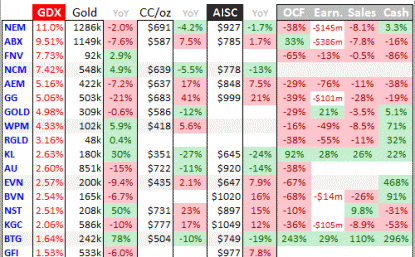
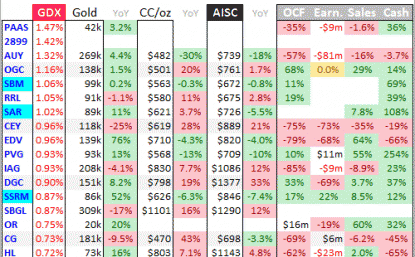
Part 1: Location, Location, Location.
You’ve heard it before and it’s always worth repeating.
In the mineral exploration and mining business a great location is of monumental importance.
But what makes a location great?
If you asked 100 industry experts I can guarantee they’d all rank the following three components highly in their answer (and I don’t use the “guarantee” word very often):
- Mineral Endowment – the location should be geologically prospective for finding commodities, preferably in abundance.
- Infrastructure – the location should be accessible, preferably with some ease of access (electricity and milling facilities nearby are a huge plus).
- Law and Order – in a political and legal context the location preferably has a history of protecting the rights of mineral owners (governmental support in the form of low taxes, ease of permitting, and subsidies are a huge plus).
Saskatchewan is one of those rare locations that reliably offers all three components.
In fact, the Fraser Institute has ranked Saskatchewan #1 for investment attractiveness in Canada and #2 worldwide. Year after year Saskatchewan is always at or near the top of the list because mining companies appreciate Saskatchewan’s competitive tax regime, efficient permitting process, and clarity concerning land claims.
Geologically speaking Saskatchewan is target rich, yet underexplored. While best known for having the largest high-grade reserves in the world for potash and uranium there’s also a wealth of resources in development and waiting to be discovered, including gold, copper, nickel, zinc, and diamonds.
Saskatchewan is very rich in terms of infrastructure too, so is it any wonder why the Fraser Institute ranks this location so highly?
No it isn’t.
The only wonder at work here is why this top ranked mining jurisdiction remains largely unexplored via modern day exploration methods.
Massive sulphides place Flin Flon squarely on the world map.
Tom Creighton is a guy you’ve probably never heard of, but you should know his name because Creighton is one of the legends in Canadian mining history.

Thanks to a rusty gossanous outcrop (and a tip from native trapper David Collins, according to legend) Creighton identified what we know today as the Flin Flon mining camp. His discovery and determination over 15 years led to the construction of a smelting plant in 1930, the most northerly smelting plant in the British Empire. To this day, nearly a century later, Hudbay (HBM, TSX) still owns much of the Flin Flon mining camp and its associated production facilities.
Mining isn’t only a tradition in these parts (smack dab on the northerly border of Saskatchewan and Manitoba) but a major source of employment for local communities including Creighton, Flin Flon, and Denare Beach.
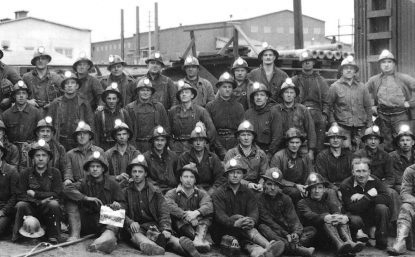
Closing down the mines and smelters isn’t really an option, despite Hudbay routinely being under threat of doing so.
Generating +10,000 tonnes of ore per day, year after year, to feed these hungry facilities is a constant grind.
Analysts are now projecting Hudbay only has a few more years left to live, again.
Research and innovative thinking positions little known “project generator” to capitalize on major exploration opportunities, plus existing infrastructure, in Flin Flon and throughout Saskatchewan!
Not unlike the Tom Creighton’s of the world before them, guys like Jarrod Brown, Chuck Downie, and Tim Termuende are determined. They’re determined to discover the metals that will become tomorrow’s mines.

Eagle Plains Crew Exploring the Fisher Project before the spin-out of Taiga Gold Corp.
How do they do it?
As a group, their company, Eagle Plains Resources (EPL, TSX-V) specializes in grassroots exploration. So in addition to boots-on-the-ground prospecting they’re guided by a proprietary geologic database, innovative thinking, and modern day technology.
Almost nothing generates new wealth faster than finding a mineral deposit, but the work is risky and expensive. Very few companies have a proven track record of success and sustainability, like Eagle Plains. Their conservative nature, experience, and determination, coupled with exploration incentive programs from governments (see Saskatchewan’s “Targeted Mineral Exploration Incentive” program) are ultimately what keep mining towns like Flin Flon alive.
Given the prolonged downturn in potash and uranium prices Saskatchewan has been seeking to diversify its economy further into precious and base metals. But right now that metals mining portion of the economy consists of just a few key players, namely Hudbay and SSR Mining (SSRM, TSX).
*Editor’s Note: Hudbay’s mines are located in Manitoba, but Saskatchewan borders them to the west and many communities nearby rely on the mines for work and sustaining commerce (geology there is very prospective for similar VMS-style mineralization)
Eagle Plains, 13 projects in the distant shadows of headframes…
Hudbay has been a fixture in the region for nearly a century, and they aren’t going anywhere. There’s no way Hudbay just shuts down and walks away from billions worth of infrastructure and liabilities. But as always, new orebodies must be discovered to feed +10,000 tonnes of material per day into the mills.
Secondarily, a real game changer for this region surfaced in 2016 when SSR Mining acquired Claude Resources’ Seabee mine for $337 million. Only a year later SSR Mining announced a seven-year, $90 million expansion plan with an aim toward increasing production and extending Seabee’s mine life into the mid-2020s (for a total investment of nearly half a billion dollars!).
So now you’ve got two companies, Hudbay and SSR Mining, with a combined market value of $3.3 billion who’ve staked much of their livelihoods on the northern border of Saskatchewan/Manitoba (Flin Flon region).
Eagle Plains, with a market cap of $8 million saw this future unfolding years ago. Ever since they’ve been positioning themselves and shareholders accordingly.
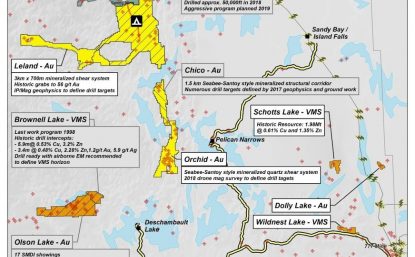
With 13 projects within the distant shadows of headframes, many of which are already proven to host mineralization, it’s hard to envision a scenario whereby Eagle Plains won’t play an important role in the futures of Hudbay and/or SSR Mining. And that’s only what we know right now, Eagle Plains is always working strategically behind the scenes to acquire prospective land packages.
To the point of securing their future at Seabee, SSR Mining already signed a multi-million dollar joint venture with Eagle Plains (now “Taiga Gold”) on their Fisher property. I’ll dig into the strategic nature of that deal in Part 2: It’s Only Natural. Coming soon…
About the author: Starting out, Daniel Cook was a stockbroker during his college years. At the age of 23 he founded his own Registered Investment Advisory (RIA) firm. Daniel is a full-time investor and prospector of the markets, constantly digging for exceptional opportunities. Helping those companies get discovered and gain traction in the marketplace is Mr. Cook’s main objective.
The recent weakness in Gold and gold mining stocks is not over. In fact, we are worried about another leg down getting underway.
If that comes to pass, we are positioned to profit from it. But I digress.
Long-term oriented investors and speculators should be aware of the near term trends but they should also be aware of the conditions that will lead to a shift from a bear market to a bull market.
Here, we focus on five factors that precede major bottoms in precious metals.
Gold Outperforms the Stock Market
Other than in 1985 through 1987 there has never been a real bull market in Gold without it outperforming the stock market. A weak stock market usually coincides with conditions that are favorable for precious metals. That’s either high inflation or economic weakness that induces policy that is usually bullish for precious metals. The 2016-2017 period failed to be a bull market because the equity market continued to outperform Gold. Note that the Gold to Stocks ratio bottomed prior to the 2001 and 2008 bottoms.
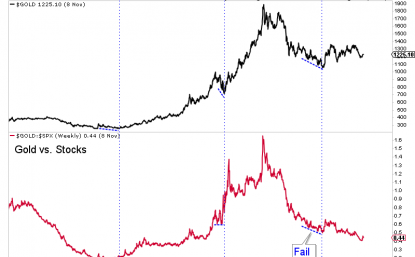
Gold Outperforms Foreign Currencies
Gold outperforming foreign currencies is important because this usually happens while the US Dollar remains in an uptrend. It signals relative strength in Gold and shows that Gold is not being held hostage by the strong dollar. It also can signal a coming peak in the dollar. Gold was outperforming foreign currencies prior to the 2001, 2008 and late 2015 bottoms. There are currently no positive divergences in place.
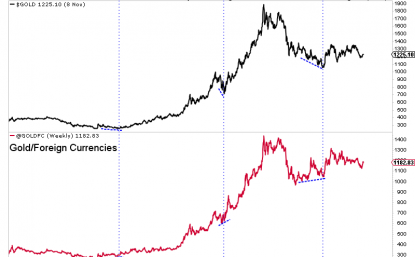
Major Peak in the US Dollar
This does not precede bottoms in Gold as it typically is a lagging indicator. But a list of “4” things does not carry the same weight as five. Anyway, Gold is not going to embark on a major, long-lasting bull market without a corresponding peak in the US Dollar. Sure, they can rise at the same time and for months on end. However, it’s difficult to imagine a multi-year bull market in Gold without a corresponding peak in the dollar. Peaks in 1993 and 2016 led to brief runs in Gold but those were nothing like the 1985 and 2001 peaks.
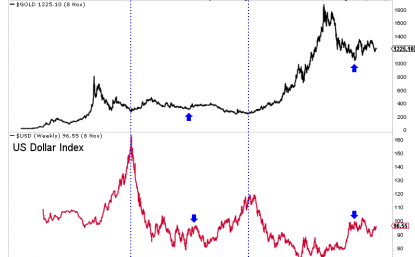
Gold Mining Stocks Crash
This is not a mandatory component of major bottoms but definitely is something that can occur before a major bottom. Below we plot GDM, which is the forerunner to GDX. Note that gold stocks essentially crashed into their late 2000 and late 2008 lows. They also crashed into their summer 2015 low which wasn’t the final low for the sector but was for the senior miners. The main point is that if gold mining stocks fall apart again it could very well be a sign that a bottom is almost imminent.
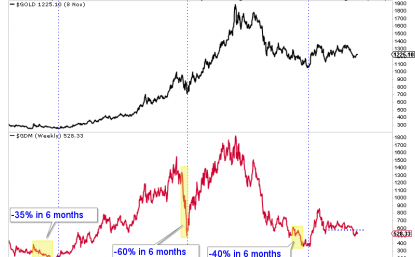
Fed Policy Change
Over the past 60 years, gold stocks have often bottomed almost immediately after the peak in the Fed Funds rate (FFR). In 10 of 12 rate cut cycles, gold stocks bottomed a median of one month and an average of two months after the peak in the FFR. The average gain of gold stocks following that low was 185%. There are also points where the gold stocks declined during a period of rate cuts or no Fed activity. Bottoms then were sometimes followed by the start of Fed hikes. However, given the current conditions, we are quite confident that gold stocks will bottom immediately after the Fed’s final rate hike.
Now you know what to look for to signal that a major bottom is imminent.
Better yet, consider our premium service which can help you ride out the downside and profit ahead of a major bottom in the sector. To prepare yourself for an epic buying opportunity in junior gold and silver stocks in 2019, consider learning more about our premiums service.
- US elections are here!
- Please click here now. Double-click to enlarge this big picture chart for gold.
- From both a technical and fundamental perspective, gold looks solid.
- This chart suggests that whatever happens in the US election, it’s going to be positive for gold.
- One of my biggest predictions for the fall of 2018 was that a US stock market sell-off would see gold and gold stocks begin to function as the ultimate safe haven.
- That happened exactly on cue, and to get an idea of how mainstream media is beginning to open their eyes to this theme, please click here now. Bloomberg Intelligence is highly respected by the global institutional investor community.
- It’s really unknown whether the stock market will rally or decline from here, but the odds are now astronomically high that when the next decline does happen…
- The world gold community will be smiling because their precious metal investments will perform admirably!
- Please click here now. The Fed’s QE and low rate programs incentivized corporations to launch enormous stock buyback programs and incentivized both retail and institutional investors to buy stock with borrowed money.
- Merrill’s chief equity market technician is very concerned about the current divergence between the price of the SP500 index and the total US market margin debt.
- I’ve predicted that as this business cycle ages, inflation would make a surprising appearance that would catch most analysts off guard.
- On that note, please click here now. In America, inflation could stage a shocking move to the upside if the emerging divergence between the interest rate on commercial bank excess reserves and the Fed Funds rate grows.
- Even if that doesn’t happen, global inflation is clearly on the move, and the move is to the upside!
- Please click here now. Western gold bugs may hate the Chinese government for good reasons, but that doesn’t change the fact that it generally acts more like a lean and mean corporation than like a government, in terms of efficiency.
- After accounting for inflation, Chinese real GDP growth is about 3%, and the same is true for India. In the West, most countries have flat or negative real GDP growth.
- The same is true for wage growth.
- The simple reality is that gold is becoming the world’s most stable asset because three billion Chindian citizens are maniacal savers, obsessed with gold, and getting richer.
- The standard of living of these citizens is increasing at a tremendous rate. An immigrant caravan headed towards the US border gets American citizens wildly excited while they buy no gold and try in vain to fix a US stock market price chase that has gone badly wrong.
- What’s missed in all the caravan-oriented excitement is that the entire caravan is composed of perhaps 10,000 people…
- While every single day there are about 50,000 babies born in India, and almost every one of them will become a maniacal gold buyer as they reach maturity.
- The bottom gold bull era line: Are babies golden? Absolutely! Gold-oriented Chindia is a titanic force that just keeps growing.
- Please click here now. Double-click to enlarge this short-term gold chart. Keep my big picture gold chart in mind when viewing this chart. A fabulous double-bottom pattern is in play.
- Please click here now. Double-click to enlarge this key GDX chart.
- There’s solid technical action taking place around a decent inverse H&S bottom pattern. It’s a consolidation of the upside breakout. Please click here now. Gold stock investors should prepare to surf a global inflationary wave, that is already shocking institutional analysts even though it is only in its infancy right now!
Risks, Disclaimers, Legal
Stewart Thomson is no longer an investment advisor. The information provided by Stewart and Graceland Updates is for general information purposes only. Before taking any action on any investment, it is imperative that you consult with multiple properly licensed, experienced and qualified investment advisors and get numerous opinions before taking any action. Your minimum risk on any investment in the world is: 100% loss of all your money. You may be taking or preparing to take leveraged positions in investments and not know it, exposing yourself to unlimited risks. This is highly concerning if you are an investor in any derivatives products. There is an approx $700 trillion OTC Derivatives Iceberg with a tiny portion written off officially. The bottom line: Are you prepared?
The Golden Triangle (GT) in northwestern British Columbia (Canada) is a tremendous place to explore and make precious & base metal discoveries. It’s known for monster high-grade gold deposits, but also hosts silver, copper & other base metals. When one considers the GT, one might think of Pretium Resources’ new bonanza-grade gold (Au) mine. Pretium has an Enterprise Value of about C$2.6 B. But, there are many prominent players in the GT, including; Teck Resources, Barrick Gold, Goldcorp, Newmont Mining, Antogagasta, Hecla Mining, Hudbay, Centerra Gold, Hochschild, Seabridge Gold, & SSR Mining.
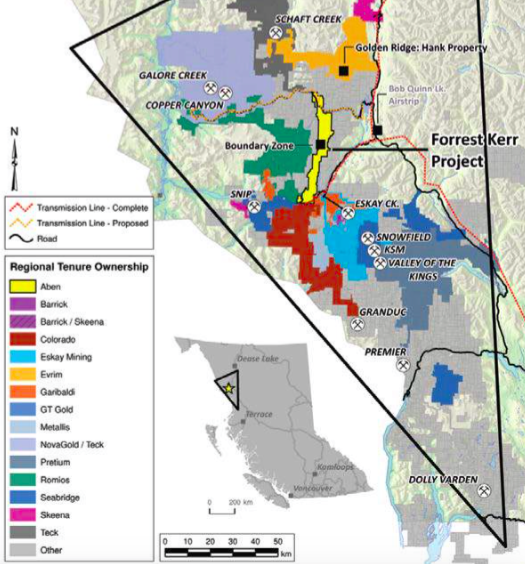
Past producing mines include Premier, Snip & Eskay Creek. Other well known mines/development projects include Brucejack, Galore Creek, Copper Canyon, Schaft Creek, KSM, Granduc & Red Chris. Eskay Creek reportedly produced 3.27 M ounces of gold at 49 g/t Au and 158 M ounces of silver at 2,406 g/t. So yeah, this isn’t just a top Canadian jurisdiction, it’s a world-class destination.
New Infrastructure & Discoveries Drawing Attention to Golden Triangle
A very important factor in the GT’s reemergence last year is that to a large extent, success for one player is success for all. For example, Pretium’s (and other’s) development over the past decade led to very significant improvements in critical infrastructure. There’s the paving of the Stewart-Cassiar highway (Highway 37) north from Smithers, the Northwest Transmission Line, a C$700 M 344-km, 287-kilovolt power line was finished in 2014 and the completion of a 3 dam, 277 MW hydroelectric facility ~70km northwest of Stewart. Also near Stewart, year round access to improved Stewart deep water ocean Port facilities.
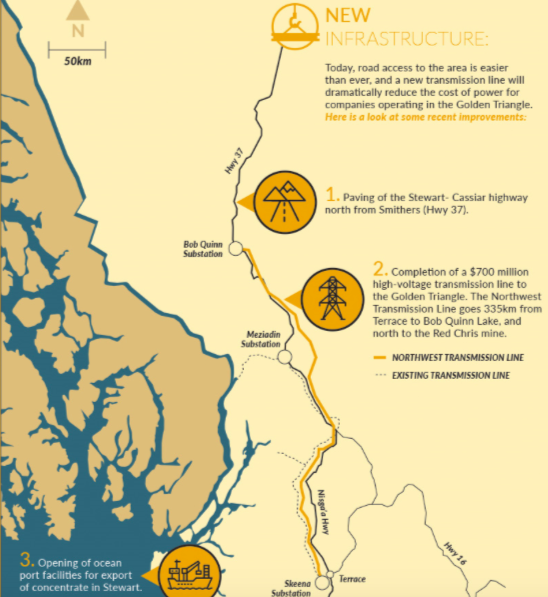
Of course, wherever there’s blockbuster discovery potential, one will find dozens of juniors hoping to cash in by controlling land reasonably close to the most exciting (existing and past producing) mines and development projects. The GT has its share of those juniors, many of whom are too small to fund the drill campaigns needed to maximize the chances of making noteworthy discoveries. Readers beware, the GT mints both kings and widows, far more of the latter.
On the heals of Pretium’s success in reaching production last year, and exciting new discoveries by companies including GT Gold Corp., Garibaldi Resources, Golden Ridge, Colorado Resources and Aben Resources, the GT is a hot place to be (for at least the third time in its history!).
Aben Resources, Early Stage, Blue-Sky Potential + Well Funded
Of the new discovery companies mentioned above, I think that Aben Resources (TSX-v: ABN)/(OTCQB: ABNAF) is particularly interesting. Its 3 discovery holes in the GT were drilled in 2017, but the Company delivered a monster assay from the first hole of the 2018 season. It returned 4 separate high grade zones within 190 m downhole, including a thin 331 g/t Gold over 1 m within a broader interval of 38.7 g/t Au over 10 m (from 114 to 124 m), incl. 62.4 g/t Au over 6 m. The other intervals included 22 g/t Au, over 4 m, 3.9 g/t Au over 13 m and 8.2 g/t Au over 6 m. 38.7 g/t Au over 10 m, that’s a grade x thickness (“GT”) of 387, one of the better assays announced in the entire Golden Triangle region this year or last. {See November Corp. Presentation}
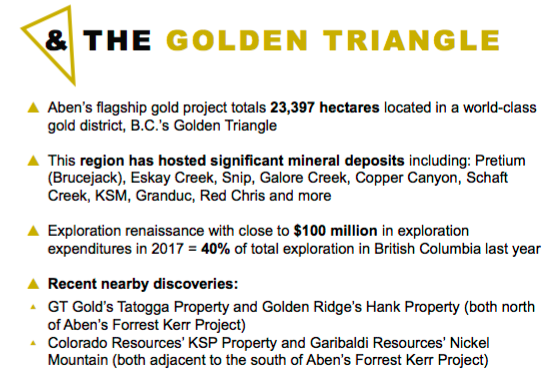
Importantly, Gwen Preston “The Resource Maven” put out a very informative and positive report on Aben Resources last week, causing trading volume and the share price to rise. This is a true vote of confidence from a woman with multiple successes, including her backing of Great Bear Resources—one of the best junior mining stories of 2018.
Still, while the potential rewards are high, the risks are well above average because the region is extremely complex geologically. Complex means that, at the very least, considerable time & capital consuming exploration needs to be done. Adding to the complexity is that, due to its far northern location, most of the camps in the GT can only be explored for half of the year. Helicopters are often required to fly manpower and equipment in and out, so exploration costs are high.
As mentioned, infrastructure in the region continues to improve, a fact well documented in peer group corporate presentations. In speaking with Aben’s management team, I can add to the narrative — Aben slashed all-in exploration costs this year to approximately C$235/meter from nearly C$400/meter in 2017.
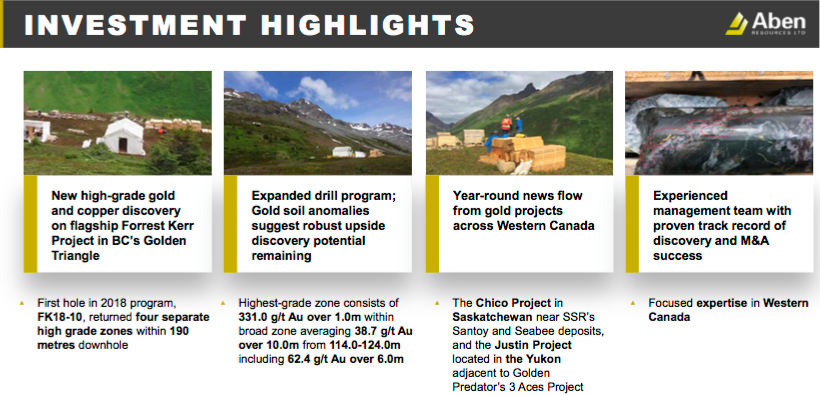
Management reports an increasing number of service companies in the GT, helicopter service providers, drilling & equipment contractors, etc., and competition is driving down costs. The company was also able to set up camp closer to drill sites, cutting down on flying time.
Cash is King in Gold Exploration, Aben Resources is Well Funded
One of the best things Aben Resources has going for it is its substantial cash liquidity, currently at ~C$7 M. Comparing Aben’s cash balance with that of the peers listed below, notice that it has the strongest cash liquidity relative to market cap. Among the peers I would say at least half need to raise capital in the next few months, or certainly before resuming drilling. By contrast, Aben is funded for its next GT drill campaign. At C$220/meter in 2019, a bit below 2018’s all-in costs, it could do potentially 18,000 m (60-70 holes) for a total cost of C$4 M. That’s a serious amount of drilling, more than in 2017 & 2018 combined. Including the 24 unreported holes from this year, that’s perhaps 80-90 holes that will reported well into next year.
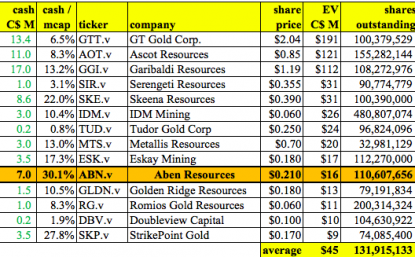
Although the share price has been disappointing lately — down to C$0.21 from the mid C$0.40’s in August after the announcement of the first hole of the season — with 24 holes yet to be reported, I think this story could have legs. The weakness in Aben shares came the day after a press release by fellow GT junior Golden Ridge Resources posted news that the market didn’t like, sending that stock plunging.
However, in the case of Aben Resources, in their most recent press release they reported on 3 holes in the South Boundary Zone, 1.5 km south of the where the high-grade results have been found in the Northern Boundary Zone. These holes provide a great deal of information for future drilling next year, but did not hit any blockbuster grades, so Aben shares sold off on the news. CEO Jim Pettit remarked,
“Discovering this new zone of mineralization over 1.5 km from the known high-grade gold mineralization at the North Boundary zone is a significant development for the company and illustrates the robust discovery potential over the relatively untested four km by two km soil geochem anomaly. There is a distinct presence of a very strong and broad mineralizing event that needs to be followed up with more drilling. There has never been any drilling in the South Boundary zone area and on the west side of the valley oriented toward the Kerr fault, so this has truly opened up a whole new area for future exploration.”
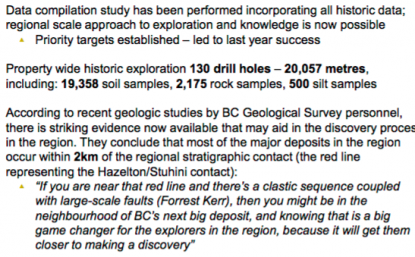
The real excitement remains on the open assays are from the Northern Boundary zone, host of the best results to date. Importantly, the soon to be reported holes were drilled after the results from the Company’s blockbuster hole were known. So, they were targeted based on valuable information. Therefore, I think there’s a decent chance of additional strong assay announcements between now and the end of the year.
Eric Sprott is in 3 GT plays, His Most Recent Pick? Aben Resources
Eric Sprott is invested in 3 GT plays, Garibaldi, Metallis Resources and Aben Resources. He knows precious metals better than most and knows the GT extremely well. Mr. Sprott chose Aben Resources over several others he could have backed this year. Importantly, Mr. Sprott invested recently, in August, 2018 and paid C$0.30 per share + warrants at C$0.45. Today readers can buy into Aben at a 30% discount to Eric Sprott’s cost basis. Someone like Sprott’s group, investing at an early-stage (Just 2 drill seasons in) is likely looking for a pretty large return (commensurate with the substantial risk).
A quick note on Aben Resources’ management & Board. I argue that this a pretty strong team for a company that’s funded for next year’s drilling in the Golden Triangle and has an Enterprise Value under C$20 M. For instance, Chairman Ron Netolitzky is, without question, one of the most important modern day figures (dating back to the mid 1980s) in the history of the Golden Triangle.
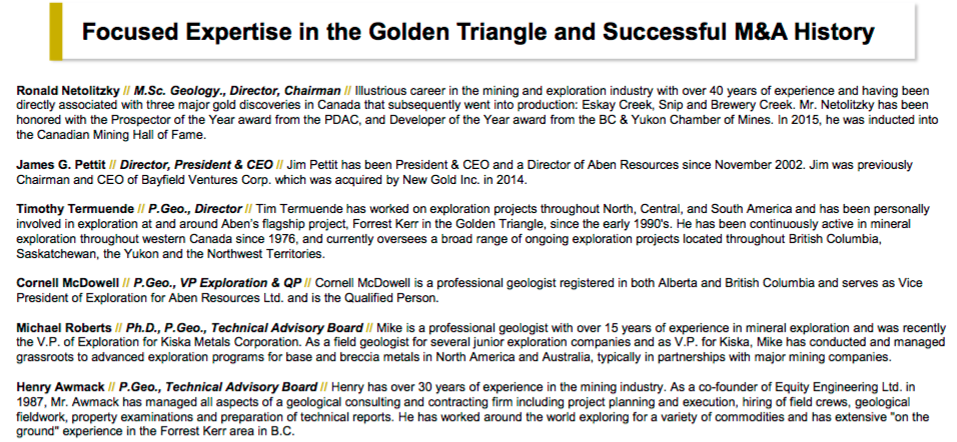
In addition to Forrest Kerr, Aben has 2 other promising projects, also in Canada. The Chico Project in Saskatchewan is near SSR Mining’s Santoy & Seabee deposits, and the Justin Project is located in the Yukon adjacent to Golden Predator’s 3 Aces Project. Assuming those projects are worth a combined C$5 M, that means Aben’s Forrest Kerr project alone is valued at {market cap – cash + debt – value of other projects} = ~C$11 M. That valuation seems quite attractive, especially for a company that’s fully funded for a robust drill campaign in the GT next year.
Think about that C$11 M valuation (for Forrest Kerr alone), that’s a cheap option on a potential development project in the heart of the GT. Please note, Aben did not recently pile into this area play, staking any available ground it could find on the fringes. Management prudently assembled, over a period of nearly 3 years, what it believes is a highly prospective property, consisting of a good-sized land package of 23,400 contiguous hectares.
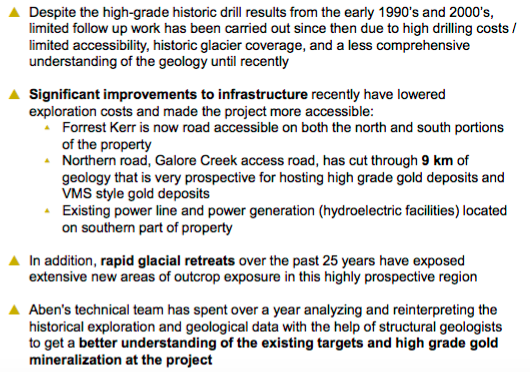
Compare that C$11 M to the valuation GT Gold’s main project Tatogga, a 43,100 hectare property (about twice the size of Forrest Kerr). If one backs out that company’s secondary project, Tatogga has an EV of roughly C$180 m (~16x that of Aben). To be fair, Tatogga has way more drilling on it than Forrest Kerr, for example doing about twice the amount of drilling (18,000 m vs. 9,900 m) in 2018. Aben is still in the early stages of drilling the first of many targeted zones. Earlier stage, more risk, but more potential return?
Make no mistake, GT Gold is well ahead of Aben and warrants a significant premium, I’m not trying to compare apples to apples. But, Aben has 24 assays remaining to report this year and is funded for 60 or more holes in the GT next year. I think some high-grade hits with good interval widths could begin to close the valuation gap with larger peers.
In all the talk about the prospects of the GT, it’s noteworthy that there’s been some real excitement around discoveries there despite a lackluster underlying gold price (in USD). If one is bullish like I am on gold, a level of say US$ 1,350/oz (+10% from today’s price) next year would do wonders for all gold stocks, but perhaps no other group would benefit more than the GT juniors.
Interview: Ellis Martin Report (October 21st)
November Corp. Presentation
Interview October 19th
Disclosures: The content of this article is for information only. Readers fully understand and agree that nothing contained herein, written by Peter Epstein of Epstein Research [ER], (together, [ER]) about Aben Resources., including but not limited to, commentary, opinions, views, assumptions, reported facts, calculations, etc. is to be considered implicit or explicit investment advice. Nothing contained herein is a recommendation or solicitation to buy or sell any security. [ER] is not responsible under any circumstances for investment actions taken by the reader. [ER] has never been, and is not currently, a registered or licensed financial advisor or broker/dealer, investment advisor, stockbroker, trader, money manager, compliance or legal officer, and does not perform market making activities. [ER] is not directly employed by any company, group, organization, party or person. The shares of Aben Resources are highly speculative, not suitable for all investors. Readers understand and agree that investments in small cap stocks can result in a 100% loss of invested funds. It is assumed and agreed upon by readers that they will consult with their own licensed or registered financial advisors before making any investment decisions.
At the time this interview was posted, Aben Resources was an advertiser on [ER]. Readers understand and agree that they must conduct their own due diligence above and beyond reading this article. While the author believes he’s diligent in screening out companies that, for any reasons whatsoever, are unattractive investment opportunities, he cannot guarantee that his efforts will (or have been) successful. [ER] is not responsible for any perceived, or actual, errors including, but not limited to, commentary, opinions, views, assumptions, reported facts & financial calculations, or for the completeness of this article or future content. [ER] is not expected or required to subsequently follow or cover events & news, or write about any particular company or topic. [ER] is not an expert in any company, industry sector or investment topic.
If you would like to receive our free newsletter via email, simply enter your email address below & click subscribe.
CONNECT WITH US
Tweets
Tweet with hash tag #miningfeeds or @miningfeeds and your tweets will be displayed across this site.
MOST ACTIVE MINING STOCKS
Daily Gainers
 Lincoln Minerals Limited Lincoln Minerals Limited |
LML.AX | +125.00% |
      |
GCR.AX | +33.33% |
      |
CASA.V | +30.00% |
      |
AHN.AX | +22.22% |
      |
ADD.AX | +22.22% |
      |
AZM.V | +21.98% |
      |
NSE.V | +21.05% |
      |
DYG.V | +18.42% |
      |
AAZ.V | +18.18% |
      |
GLA.AX | +17.65% |

 Follow us on Twitter
Follow us on Twitter Become our facebook fan
Become our facebook fan
